Early Khoja/Ismaili settlements in Africa
Early Khoja/Ismaili settlements in Africa
The Intrepid East Africa Dukawalla:
by: I. I. Dewji, Editor, khojawiki.org (2019)
(You can also read a more detailed version of this article with references, Dukawalla poem and photographs by clicking here)
http://r20.rs6.net/tn.jsp?f=0017adAvrss ... zXPdbSYg==
(Click on the names in brackets (xx) for the personal stories of the dukawallas and other articles in Khojawiki.org)
Ocean Trade - Indian Famines
“The Nizari Khoja had been active as traders between western India and coast Africa at least since the 17th century: the early Indian Nizari immigrants came as well from Kutch, Kathiawar, Surat and Bombay, and settled on Zanzibar Island. By 1820, a small community of Khojas was present in Zanzibar: .." (1)
(See Khoja Shams-ud-din Gillani)
Though Indian merchants were plying the eastern seaboard of Africa from the dawn of history and certainly after the Arab-Muslim conquests (see Zanzibar), the term "Dukawalla" (shopkeeper - derived from the "dukan"- Kutchi for shop) refers to the mainly Khoja/Gujarati migrants who during the Swahili, Omani and European rule in the 19th and 20th century, opened the African hinterland from the coast to the Congo, linking the indigenous inhabitants to the ancient Indian Ocean trade and exports.
Attracted by opportunities created by their caste and family connections and forced out by famines in India in the mid 1800’s, See Gujarat Famines & Khoja Migrations, these Indians migrant families, some peasants themselves from rural Kutch were looking at a hardy future in Africa, often dying of unknown diseases and animals attacks but lured by the stories of rich rewards on the “Zanz” side of the Indian ocean.
See Nathoo Hirji Nathani
Notwithstanding initial mutual apprehension, the dukawallas were universally welcomed by the indigenous Africans who saw them as their windows into the world of fascinating new goods and inventions.

(Read the beautiful poem by Kersi Rustomji "Ode to a Dukawalla on the East African Plain")
Crossing the Kala Pani
In order to create their own “rags to riches” life, the migrants first had to survive a treacherous sea-voyage on ancient Arab dhows, travelling from the ports of Gwadar, Ormara, Mandvi and Muscat to the faraway Mombasa & Zanzibar. The rate of survival was so low and costs of fare was so high that the Gujaratis sorrowfully called this voyage “Crossing the Black Waters”- because those who went rarely returned to India.
After 1914, most travelled from Porbander or Bombay by steamships but even those better constructed European ships were not always safe.
“The coast of East Africa stretches some 4,000 miles from Cape Guardafui in Somalia to the Mozambique Channel. It is rugged and inhospitable, with few safe anchorages, miles of treacherous coral reefs and a strong northerly current. Over the years, it has become a ship’s graveyard to the unlucky ones, and a dire warning to those that ran aground and were subsequently refloated. ..Using records…., the author discovered the stories of over 200 merchant and naval ships that came to grief.” (2)
"Before 1914 and during the two world wars when steamer traffic was interrupted, almost all the Asians came by dhow. Life on these small ships of 80 to 350 tons, 40 to 60 feet long, with wooden hulls and lateen sails, was difficult. The passengers slept on deck and, clustered in groups’ representative of different religious communities, cooked their own food. They had no privacy and lacked any competent medical service. The ships bobbed and rolled off the monsoon seas even in calm weather, and seasickness was common. A storm — and rarely could one escape one or two during the voyage — was a frightening experience.”
“Under the most favorable conditions, the voyage of 2,400 miles to Zanzibar could be made in twenty-six days, but a storm or a calm could extend it by several weeks or even months. Nasser Virji's passage from Kutch in 1875 took nine months.” Sultan Somji, author of "BEAD BAI" provides a more detailed lyrical but terrifying account of one such a voyage in this book.
Caste, Family and Other Assets
If they made it across safely, most Indians started their new life with no capital, having spent the family's meager life savings on the dhow fare.
"Most Asian immigrants arrived penniless…-and looked to relatives to find them jobs with established merchants." (3)
“Once in East Africa, these early immigrants often went through several weeks or months of uncertainty and privation while determining their initial location and employment. Although some had a smattering of English, very few knew any German, Arabic or Kiswahili (4)
The Khoja & other Gujarati migrants had several advantages over other local entrepreneurs. For thousands of years, India has had a well-developed commercial economy and the migrants came equipped with basic skills that proved handy in the new land.
"They were, more than Swahilis, accustomed with a money economy and the concept of interest. In addition, they knew how to read, write and produce account books." (5)
Secondly, being members of ancient trading castes/communities, they had knowledge both of travel and trade. Since the early 1500’s, the Khojas were led by veteran traders and later accomplished Bombay businessmen, whose networks spread from old Mughal ports of Surat, Mandvi & Porbander, the Omani ports of Gwadar & Ormara to Bandar Abbas, Jeddah, Muscat, Bombay, Mombasa, Kilwa and Zanzibar. These strong connections of caste and family provided welcome familiarity and vital support to the Indians in their settlement in East Africa.
(see Ties of the Bandhana by Safder Alladina)
See Hassanali Walji Kanji
“For Indians, particularly recent migrants and those without capital, reliance on kin and patrons for shelter and shop work was an essential step towards autonomy, accumulating capital and establishing one's own business. While it absorbed many migrants, shop hours were long, conditions poor and incomes - though five to ten times more than for African shop workers — were ‘meager’ This period of ‘training’ was later followed by a small salary and perhaps credit or other assistance to set up a shop”. (6)
See Kassamali Hirji Jessani
"This apprenticeship-"service" in the derogatory Gujarati term-was endured until a man could break away, first as itinerant trader and then as resident shopkeeper, taking his stock on credit from a wholesaler" (7)
See Madatally Manji
See Nurmohamed Jiwa Ukani
"Others worked as shopkeepers or clerks for wholesalers [mostly, but not always within the family or community] and started their own business elsewhere in Zanzibar, or one of the other islands, or in the port cities of the mainland. They usually left with their goods, which they had to repay in 90 days.” (8)
For the migrants, the certainty of a path to success was crucial incentive to undertake the dangerous trans-oceanic journey - the established merchants needed outposts to distribute their stock and newly arrived migrants needed immediate work to subsist and send money back to their poorer family. They were motivated and worked hard to prove their worthiness for a loan.
(see Allidina Visram and his relationship of Sewa Haji Paroo)
"Subsequently, the Indian Ismaili moved from Zanzibar to growing urban areas on the east coast of Africa, notably Mombasa, Tanga and Bagamoyo, where they acted as commercial agents for firms in Zanzibar or became petty merchants and shopkeepers.”(9)
See Alarakhia Dossani
The Indian migrants in 1800’s were mostly Kutchis Khoja farmers and labourers lured by the success of merchants travellers such as Taria Toppan and Peera Dewjee and others from Bharapur, Kera etc. who frequently returned home marry etc.
Early 20th century, it was their fellow caste-members, the mostly Gujarati-speaking Khojas of Kathiawar, who were motivated and sometimes recruited by merchants princes like Allidina Visram, Nasser Virji etc.
‘Pioneers like Allidina Visram explored the areas themselves. They established extensive upcountry duka (small shops) networks throughout East Africa and invested in real estate, plantations, shipping and ginneries’.(10)
See Hasham Jamal Pradhan
These new migrants (so-called “Nangarias” –possibly because they arrived in steamships with large “nangars” anchors?) were better equipped small traders, retail hawkers and artisans from cities like Jamnagar, Rajkot, Porbander and the many villages of Kathiawar where the Khojas lived in small colonies.
"The immigration to East Africa was therefore a spontaneous one. An enterprising young man who wanted to emigrate had to find his own fare across the ocean or persuade a relative already established in Africa to pay it and help him on arrival. For this reason the poorest classes in India did not come to East Africa, nor did the rich and well-educated. In addition, only those living reasonably close to convenient ports were likely to make the journey. Consequently the Indian immigrants to East Africa were not usually unskilled labourers, as were the Indian settlers in South Africa, Mauritius, Fiji, and the West Indies, who had been recruited for plantation labour in tropical agricultural colonies. The East African settlers were mainly petty traders and artisans, and though most of them came from a background of village and farm, almost none took to farming, in spite of the hope of the administration of the East African Protectorate at the beginning of this century that they might." (11)
To find a suitable location for their own duka, they followed the earlier Khoja merchant-traders, who had had worked along the old Arab caravan trade inland from Bagamoyo.
"The South Asian Khojas, Tharia Thopan (1823-?), Sewji Haji (1851-1997), Allidina Visram (1851-1916) and Nasser Veerjee (1865-1942), were among the principal financiers of caravan traders in the late nineteenth century. Most of them managed their businesses from the coast, but they gathered first-hand information on the inland trade routes". (12)
The earliest record of a Khoja dukawalla/trader in the interior is Musa Kanji (or Musa Mzuri – “Musa, the Good”, as he was called by the European explorers such as Grant), who was said have lived in Tabora from the 1840’s. Many Khojas can trace their ancestors to Bagamoyo, Tabora (known then as Kazeh) or Kigoma (known then as Ujiji) as well as Mwanza and Bukoba, which were old Swahili/Arab settlements in the interior.
After 1890, the German started to build a string of “Bomas” administrative centres across their new colony and the Dukawalla generally set up shop nearby so as have maximum security during the bloody colonisation period. It is reported that over 1000 traders followed the German Major Prince when he moved to the Iringa & Tukuyu area.
(See Gulamhusein Moloo Hirji)
In 1910, the Germans started building the “Central Railway” and the Indian dukawallas helped to create towns like Morogoro, Dodoma and Kigoma. Arusha & Moshi were the result of the German-built Usambara Railway system.
“Whereas in 1901 only 58 of 3,420 Asians are known to have lived in interior districts, by 1912 the figure was 8,591 out of 8,698. German administrative centres attracted storekeepers.".(13)
Across the border in the East African Protectorate, when the British started building the Uganda Railway from Mombasa in 1891, the rail-head stations made convenient trading posts for the Dukawallas, who were set-up by the merchant princes like Allidina Visram and others.
“By the 1870, there were some 2,500 Ismaili Khojas in East Africa and their ranks swelled even further after the establishment of the British Protectorate in 1891 (i.e. Kenya and Uganda, Editor.) "(14)
see Mohamed Manek
see Kassim Lakha
The dukawallas also moved into the unexplored hinterland setting up mud and corrugated iron shops in villages at the edge of civilization providing rations and essentials of life to the indigenous peasants and in the towns to German & British administrators.
See Kersi Rustomji's wonderful poem for a detailed description of the amazing array of goods and experiences they brought to the indigenous Africans..
See Mohamedali Remtulla Mulji
The Dukawallas were able to endure the lonely bush-life by taking solace that by escaping poverty & famine, they were able to provide for their families. The Omani Sultans who had first welcomed them in Muscat & Gwadar and later in Zanzibar were Ibadi Muslims, a minority sect with a centuries-old history of Indian Ocean trading and tolerance of the smorgasbord of the Indian faith systems. The Khojas and other Gujarati migrants, being members of ancient Indian spiritual communities, practised their dharma (faith) through “sewa” volunteer service within their respective castes in these small towns in East Africa. (Later, after Independence, this entrenched communalism born out of necessity, but from a different era, became a ground for resentment by some indigenous Africans.)
For a detailed account of Khoja dukawalla family life, read Sultan Somji’s two books, “Bead Bai” and “The Crossing”.
see see Fatmabai Kasssamali Kanji Bhatia
Earn Credit - Give Credit
The dukawallas ultimate business success lay in continually seeking new opportunities in the expanding economies, due to the systemic exploitation of the natural resources of the colonies by the Europeans.
“All Indian businesses.....relied heavily on credit systems. Supply-line credit from European and Indian merchant houses, often based on ninety-day terms, stretched from the docks of Dar es Salaam to the smallest rural shops. ." (15)
(see Dolatkhanu Alibhai Gulamhussien Jiwani )
(see Zerakhanu Rajabali Fazal Alidina)
“Therefore, the most important ‘security’ was a person’s ‘good name’. A ‘good name’ was gained by repaying debts in time, being known among credit worthy people, and being an honest and trustworthy businessman in general. If a family’s reputation was lost, it would be very difficult to obtain new credits." '(16)
See see Hasham Jamal Pradhan
(Interestingly, back in India in the 1870’s, on the foothills of the Himalayas’ near Simla, Khoja itinerant traders were bringing merchandise from the Bombay & Delhi merchants and similarly distributing them to farmers on credit. The peddlers worked in groups and if one defaulted, the others were responsible for those debts. It would appear that a “good name” ethic was long entrenched in the Khoja business practices) (17)
The Dukawallas’ genius was to create methodologies to extend similar credit to their indigenous customers and successfully bringing them into the cash economy.
"In one common practice known as amana, Indian retailers extended credit in return for offering safe deposit of African goods or money, usually accumulated from a dowry or crop sale, which would subsequently serve as a surety for monthly store credit." (18)
Later, this spawned into the business of "pawn-shops" which became part of the retail nexus providing a vital business service in the harsh colonial system.
"...such shops also provided the nexus for the distribution of basic necessities such as food and clothing to those living month-to-month on credit margins." (19)
(See see Nurbanu Dharamsi Rawji)
"Credit was universally available at pawnshops, which in Dar es Salaam were owned entirely by Khoja Ismaili Indians, and intimately connected with most African household economics. Pledges peaked from the twentieth to the end of each month, during siku za mwambo “tight-stretched days.” Upon wage payments on the first of the month, each pawnshop in town would attend to between three and four hundred customers who queued to redeem their goods." (20)
In the countryside, another growth opportunity was a consequence of the Khoja tradition of not adopting the Muslim “purdah” for their women. As soon a new Khoja bride became adept in KiSwahili, the Dukawalla was able to leave the shop to her and go on buying sprees for local produce & artisan products and ship them to the larger urban markets. This was an important economic advantage over other Muslims and Hindus traders whose tradition was of not involving their spouses in business.
see Maherali Gokal Versi
Business Risks - Colonial Hostility
However, as Brennan points out, there were also substantial obstacles to success in retail for these small vyaparis businessmen (Later, this term was corrupted into the derogatory KiSwahili “Bepari” exploiter and used against the Indians)
"The system functioned on high turnover and small cash margins—often as little as 10 percent — offering higher profits but greater risks and frequent bankruptcies among small Indian traders." (21)
see Gulamali JIna Madhavji
"Last but not least, (5) the success of South Asian businessmen in East Africa was the outcome of a ‘trial and error’ process." (22)
see Rahemtulla Walji Virji
Gijsbert Oonk study of bankruptcies in early Zanzibar show that as many as 50% of the businesses failed in the first instance and also that failure meant a very slow route up if they wanted to access the community network of credit again.
“Therefore, it is not surprising that family members would take the responsibility for the debts of fathers, brothers, or in-laws, even if they were not legally obliged to do so. In these cases, keeping up the family name was of high priority in order to attract new or future investors.” (23)
Underlying this struggle to succeed was the insidious racism of the colonial order. The East African dukawalla endured constant harassment at hands of the European masters.
"In 1913, the Bombay Chronicle published an analysis and fierce criticism of the discriminatory policies in the British East African Protectorate (present day Kenya& Uganda: Editor). The article initially highlights the economic and political contribution of South Asians in East Africa, but then cynically stresses:
And now the Indian cannot acquire property in the uplands, cannot carry weapons, cannot enter the Market House in Nairobi, cannot travel in comfort on the steamers and railways, cannot have a trial by jury, in short cannot be anything else than an undesirable alien [emphasis added].
It is clear from the newspaper article that while the Germans and the British were colonising East Africa, they were also alienating the South Asians who lived there. Many South Asian traders and businessmen believed that due to discriminatory regulations, they were unable to compete with Europeans on an equal basis. At the same time, they were not able to defend their properties and protect their families, despite the fact that most of them were British subjects" 24)
"The writer's father, W. H. King, who fought here with the Indian Expeditionary Force from 1915 to 1918. used to say that the whole natural line of business communication between Tanga and Mombasa, Arusha and Nairobi, Kisumu and its southwestern hinterland was broken up. He described the sufferings of the indian duka keepers who were merrily raided by both sides as the battle ebbed and flowed. The Belgians coming in from the Congo into Rwanda and Burundi and then crossing the lake to push towards Tabora treated the Indian traders in the same way as they advanced and the Germans retreated" (25)
see Mohamed Dewji
see Kassam HAJI
Sir Yusufali Karimjee, speaking for Indians in Tanganyika put it well: "The policy of the Government underlying this movement is to rob Indian Peter to pay British Paul" (26)
Visible Everywhere-Invisible in History
East African cities, towns and villages display the large and indelible presence of the Indians - in the markets areas, in the urban buildings, in the residential suburbs, in the foods and in the public infrastructure.
"South Asians in East Africa are written out of history. They do not play an important part in the textbooks on Tanzanian, Kenyan and Ugandan history. In fact, if they are mentioned at all, they are seen as a part of people who were expelled and did not play an important part in the national histories. Furthermore, they are not part of the Indian national history as they migrated before India became independent. Finally, they are not part of the European colonial history, except for being ‘middlemen’ who could be employed for the colonial projects." (27)
The East African Dukawalla has been, for at least 150 years, a portrait of personal sacrifice and dogged tenacity. Maligned by ungrateful colonials and opportunists’ indigenous politicians, it is fitting that as Africans finally take their proper place in the world, this laudable story of endurance and enterprise by those who paved the way, is properly told.
------------------
From Khojawiki.org:
WHAT IS KHOJAWIKI.ORG
The Khoja Diaspora
We believe, as many of you also do that the incredible 700-year migratory history of the Khojas should not be allowed to die even I'd our elders pass away. Our response is Khojawiki.org - a not-for-profit collaborative effort to systematically record living people's stories about their own experiences and their recollection of the stories of their parents and other ancestors in their own words, using the power of the Internet.
-----------
On their main page, you can read from:
INDEX OF OVER 250 PERSONAL HISTORIES IN KHOJAWIKI
by: I. I. Dewji, Editor, khojawiki.org (2019)
(You can also read a more detailed version of this article with references, Dukawalla poem and photographs by clicking here)
http://r20.rs6.net/tn.jsp?f=0017adAvrss ... zXPdbSYg==
(Click on the names in brackets (xx) for the personal stories of the dukawallas and other articles in Khojawiki.org)
Ocean Trade - Indian Famines
“The Nizari Khoja had been active as traders between western India and coast Africa at least since the 17th century: the early Indian Nizari immigrants came as well from Kutch, Kathiawar, Surat and Bombay, and settled on Zanzibar Island. By 1820, a small community of Khojas was present in Zanzibar: .." (1)
(See Khoja Shams-ud-din Gillani)
Though Indian merchants were plying the eastern seaboard of Africa from the dawn of history and certainly after the Arab-Muslim conquests (see Zanzibar), the term "Dukawalla" (shopkeeper - derived from the "dukan"- Kutchi for shop) refers to the mainly Khoja/Gujarati migrants who during the Swahili, Omani and European rule in the 19th and 20th century, opened the African hinterland from the coast to the Congo, linking the indigenous inhabitants to the ancient Indian Ocean trade and exports.
Attracted by opportunities created by their caste and family connections and forced out by famines in India in the mid 1800’s, See Gujarat Famines & Khoja Migrations, these Indians migrant families, some peasants themselves from rural Kutch were looking at a hardy future in Africa, often dying of unknown diseases and animals attacks but lured by the stories of rich rewards on the “Zanz” side of the Indian ocean.
See Nathoo Hirji Nathani
Notwithstanding initial mutual apprehension, the dukawallas were universally welcomed by the indigenous Africans who saw them as their windows into the world of fascinating new goods and inventions.

(Read the beautiful poem by Kersi Rustomji "Ode to a Dukawalla on the East African Plain")
Crossing the Kala Pani
In order to create their own “rags to riches” life, the migrants first had to survive a treacherous sea-voyage on ancient Arab dhows, travelling from the ports of Gwadar, Ormara, Mandvi and Muscat to the faraway Mombasa & Zanzibar. The rate of survival was so low and costs of fare was so high that the Gujaratis sorrowfully called this voyage “Crossing the Black Waters”- because those who went rarely returned to India.
After 1914, most travelled from Porbander or Bombay by steamships but even those better constructed European ships were not always safe.
“The coast of East Africa stretches some 4,000 miles from Cape Guardafui in Somalia to the Mozambique Channel. It is rugged and inhospitable, with few safe anchorages, miles of treacherous coral reefs and a strong northerly current. Over the years, it has become a ship’s graveyard to the unlucky ones, and a dire warning to those that ran aground and were subsequently refloated. ..Using records…., the author discovered the stories of over 200 merchant and naval ships that came to grief.” (2)
"Before 1914 and during the two world wars when steamer traffic was interrupted, almost all the Asians came by dhow. Life on these small ships of 80 to 350 tons, 40 to 60 feet long, with wooden hulls and lateen sails, was difficult. The passengers slept on deck and, clustered in groups’ representative of different religious communities, cooked their own food. They had no privacy and lacked any competent medical service. The ships bobbed and rolled off the monsoon seas even in calm weather, and seasickness was common. A storm — and rarely could one escape one or two during the voyage — was a frightening experience.”
“Under the most favorable conditions, the voyage of 2,400 miles to Zanzibar could be made in twenty-six days, but a storm or a calm could extend it by several weeks or even months. Nasser Virji's passage from Kutch in 1875 took nine months.” Sultan Somji, author of "BEAD BAI" provides a more detailed lyrical but terrifying account of one such a voyage in this book.
Caste, Family and Other Assets
If they made it across safely, most Indians started their new life with no capital, having spent the family's meager life savings on the dhow fare.
"Most Asian immigrants arrived penniless…-and looked to relatives to find them jobs with established merchants." (3)
“Once in East Africa, these early immigrants often went through several weeks or months of uncertainty and privation while determining their initial location and employment. Although some had a smattering of English, very few knew any German, Arabic or Kiswahili (4)
The Khoja & other Gujarati migrants had several advantages over other local entrepreneurs. For thousands of years, India has had a well-developed commercial economy and the migrants came equipped with basic skills that proved handy in the new land.
"They were, more than Swahilis, accustomed with a money economy and the concept of interest. In addition, they knew how to read, write and produce account books." (5)
Secondly, being members of ancient trading castes/communities, they had knowledge both of travel and trade. Since the early 1500’s, the Khojas were led by veteran traders and later accomplished Bombay businessmen, whose networks spread from old Mughal ports of Surat, Mandvi & Porbander, the Omani ports of Gwadar & Ormara to Bandar Abbas, Jeddah, Muscat, Bombay, Mombasa, Kilwa and Zanzibar. These strong connections of caste and family provided welcome familiarity and vital support to the Indians in their settlement in East Africa.
(see Ties of the Bandhana by Safder Alladina)
See Hassanali Walji Kanji
“For Indians, particularly recent migrants and those without capital, reliance on kin and patrons for shelter and shop work was an essential step towards autonomy, accumulating capital and establishing one's own business. While it absorbed many migrants, shop hours were long, conditions poor and incomes - though five to ten times more than for African shop workers — were ‘meager’ This period of ‘training’ was later followed by a small salary and perhaps credit or other assistance to set up a shop”. (6)
See Kassamali Hirji Jessani
"This apprenticeship-"service" in the derogatory Gujarati term-was endured until a man could break away, first as itinerant trader and then as resident shopkeeper, taking his stock on credit from a wholesaler" (7)
See Madatally Manji
See Nurmohamed Jiwa Ukani
"Others worked as shopkeepers or clerks for wholesalers [mostly, but not always within the family or community] and started their own business elsewhere in Zanzibar, or one of the other islands, or in the port cities of the mainland. They usually left with their goods, which they had to repay in 90 days.” (8)
For the migrants, the certainty of a path to success was crucial incentive to undertake the dangerous trans-oceanic journey - the established merchants needed outposts to distribute their stock and newly arrived migrants needed immediate work to subsist and send money back to their poorer family. They were motivated and worked hard to prove their worthiness for a loan.
(see Allidina Visram and his relationship of Sewa Haji Paroo)
"Subsequently, the Indian Ismaili moved from Zanzibar to growing urban areas on the east coast of Africa, notably Mombasa, Tanga and Bagamoyo, where they acted as commercial agents for firms in Zanzibar or became petty merchants and shopkeepers.”(9)
See Alarakhia Dossani
The Indian migrants in 1800’s were mostly Kutchis Khoja farmers and labourers lured by the success of merchants travellers such as Taria Toppan and Peera Dewjee and others from Bharapur, Kera etc. who frequently returned home marry etc.
Early 20th century, it was their fellow caste-members, the mostly Gujarati-speaking Khojas of Kathiawar, who were motivated and sometimes recruited by merchants princes like Allidina Visram, Nasser Virji etc.
‘Pioneers like Allidina Visram explored the areas themselves. They established extensive upcountry duka (small shops) networks throughout East Africa and invested in real estate, plantations, shipping and ginneries’.(10)
See Hasham Jamal Pradhan
These new migrants (so-called “Nangarias” –possibly because they arrived in steamships with large “nangars” anchors?) were better equipped small traders, retail hawkers and artisans from cities like Jamnagar, Rajkot, Porbander and the many villages of Kathiawar where the Khojas lived in small colonies.
"The immigration to East Africa was therefore a spontaneous one. An enterprising young man who wanted to emigrate had to find his own fare across the ocean or persuade a relative already established in Africa to pay it and help him on arrival. For this reason the poorest classes in India did not come to East Africa, nor did the rich and well-educated. In addition, only those living reasonably close to convenient ports were likely to make the journey. Consequently the Indian immigrants to East Africa were not usually unskilled labourers, as were the Indian settlers in South Africa, Mauritius, Fiji, and the West Indies, who had been recruited for plantation labour in tropical agricultural colonies. The East African settlers were mainly petty traders and artisans, and though most of them came from a background of village and farm, almost none took to farming, in spite of the hope of the administration of the East African Protectorate at the beginning of this century that they might." (11)
To find a suitable location for their own duka, they followed the earlier Khoja merchant-traders, who had had worked along the old Arab caravan trade inland from Bagamoyo.
"The South Asian Khojas, Tharia Thopan (1823-?), Sewji Haji (1851-1997), Allidina Visram (1851-1916) and Nasser Veerjee (1865-1942), were among the principal financiers of caravan traders in the late nineteenth century. Most of them managed their businesses from the coast, but they gathered first-hand information on the inland trade routes". (12)
The earliest record of a Khoja dukawalla/trader in the interior is Musa Kanji (or Musa Mzuri – “Musa, the Good”, as he was called by the European explorers such as Grant), who was said have lived in Tabora from the 1840’s. Many Khojas can trace their ancestors to Bagamoyo, Tabora (known then as Kazeh) or Kigoma (known then as Ujiji) as well as Mwanza and Bukoba, which were old Swahili/Arab settlements in the interior.
After 1890, the German started to build a string of “Bomas” administrative centres across their new colony and the Dukawalla generally set up shop nearby so as have maximum security during the bloody colonisation period. It is reported that over 1000 traders followed the German Major Prince when he moved to the Iringa & Tukuyu area.
(See Gulamhusein Moloo Hirji)
In 1910, the Germans started building the “Central Railway” and the Indian dukawallas helped to create towns like Morogoro, Dodoma and Kigoma. Arusha & Moshi were the result of the German-built Usambara Railway system.
“Whereas in 1901 only 58 of 3,420 Asians are known to have lived in interior districts, by 1912 the figure was 8,591 out of 8,698. German administrative centres attracted storekeepers.".(13)
Across the border in the East African Protectorate, when the British started building the Uganda Railway from Mombasa in 1891, the rail-head stations made convenient trading posts for the Dukawallas, who were set-up by the merchant princes like Allidina Visram and others.
“By the 1870, there were some 2,500 Ismaili Khojas in East Africa and their ranks swelled even further after the establishment of the British Protectorate in 1891 (i.e. Kenya and Uganda, Editor.) "(14)
see Mohamed Manek
see Kassim Lakha
The dukawallas also moved into the unexplored hinterland setting up mud and corrugated iron shops in villages at the edge of civilization providing rations and essentials of life to the indigenous peasants and in the towns to German & British administrators.
See Kersi Rustomji's wonderful poem for a detailed description of the amazing array of goods and experiences they brought to the indigenous Africans..
See Mohamedali Remtulla Mulji
The Dukawallas were able to endure the lonely bush-life by taking solace that by escaping poverty & famine, they were able to provide for their families. The Omani Sultans who had first welcomed them in Muscat & Gwadar and later in Zanzibar were Ibadi Muslims, a minority sect with a centuries-old history of Indian Ocean trading and tolerance of the smorgasbord of the Indian faith systems. The Khojas and other Gujarati migrants, being members of ancient Indian spiritual communities, practised their dharma (faith) through “sewa” volunteer service within their respective castes in these small towns in East Africa. (Later, after Independence, this entrenched communalism born out of necessity, but from a different era, became a ground for resentment by some indigenous Africans.)
For a detailed account of Khoja dukawalla family life, read Sultan Somji’s two books, “Bead Bai” and “The Crossing”.
see see Fatmabai Kasssamali Kanji Bhatia
Earn Credit - Give Credit
The dukawallas ultimate business success lay in continually seeking new opportunities in the expanding economies, due to the systemic exploitation of the natural resources of the colonies by the Europeans.
“All Indian businesses.....relied heavily on credit systems. Supply-line credit from European and Indian merchant houses, often based on ninety-day terms, stretched from the docks of Dar es Salaam to the smallest rural shops. ." (15)
(see Dolatkhanu Alibhai Gulamhussien Jiwani )
(see Zerakhanu Rajabali Fazal Alidina)
“Therefore, the most important ‘security’ was a person’s ‘good name’. A ‘good name’ was gained by repaying debts in time, being known among credit worthy people, and being an honest and trustworthy businessman in general. If a family’s reputation was lost, it would be very difficult to obtain new credits." '(16)
See see Hasham Jamal Pradhan
(Interestingly, back in India in the 1870’s, on the foothills of the Himalayas’ near Simla, Khoja itinerant traders were bringing merchandise from the Bombay & Delhi merchants and similarly distributing them to farmers on credit. The peddlers worked in groups and if one defaulted, the others were responsible for those debts. It would appear that a “good name” ethic was long entrenched in the Khoja business practices) (17)
The Dukawallas’ genius was to create methodologies to extend similar credit to their indigenous customers and successfully bringing them into the cash economy.
"In one common practice known as amana, Indian retailers extended credit in return for offering safe deposit of African goods or money, usually accumulated from a dowry or crop sale, which would subsequently serve as a surety for monthly store credit." (18)
Later, this spawned into the business of "pawn-shops" which became part of the retail nexus providing a vital business service in the harsh colonial system.
"...such shops also provided the nexus for the distribution of basic necessities such as food and clothing to those living month-to-month on credit margins." (19)
(See see Nurbanu Dharamsi Rawji)
"Credit was universally available at pawnshops, which in Dar es Salaam were owned entirely by Khoja Ismaili Indians, and intimately connected with most African household economics. Pledges peaked from the twentieth to the end of each month, during siku za mwambo “tight-stretched days.” Upon wage payments on the first of the month, each pawnshop in town would attend to between three and four hundred customers who queued to redeem their goods." (20)
In the countryside, another growth opportunity was a consequence of the Khoja tradition of not adopting the Muslim “purdah” for their women. As soon a new Khoja bride became adept in KiSwahili, the Dukawalla was able to leave the shop to her and go on buying sprees for local produce & artisan products and ship them to the larger urban markets. This was an important economic advantage over other Muslims and Hindus traders whose tradition was of not involving their spouses in business.
see Maherali Gokal Versi
Business Risks - Colonial Hostility
However, as Brennan points out, there were also substantial obstacles to success in retail for these small vyaparis businessmen (Later, this term was corrupted into the derogatory KiSwahili “Bepari” exploiter and used against the Indians)
"The system functioned on high turnover and small cash margins—often as little as 10 percent — offering higher profits but greater risks and frequent bankruptcies among small Indian traders." (21)
see Gulamali JIna Madhavji
"Last but not least, (5) the success of South Asian businessmen in East Africa was the outcome of a ‘trial and error’ process." (22)
see Rahemtulla Walji Virji
Gijsbert Oonk study of bankruptcies in early Zanzibar show that as many as 50% of the businesses failed in the first instance and also that failure meant a very slow route up if they wanted to access the community network of credit again.
“Therefore, it is not surprising that family members would take the responsibility for the debts of fathers, brothers, or in-laws, even if they were not legally obliged to do so. In these cases, keeping up the family name was of high priority in order to attract new or future investors.” (23)
Underlying this struggle to succeed was the insidious racism of the colonial order. The East African dukawalla endured constant harassment at hands of the European masters.
"In 1913, the Bombay Chronicle published an analysis and fierce criticism of the discriminatory policies in the British East African Protectorate (present day Kenya& Uganda: Editor). The article initially highlights the economic and political contribution of South Asians in East Africa, but then cynically stresses:
And now the Indian cannot acquire property in the uplands, cannot carry weapons, cannot enter the Market House in Nairobi, cannot travel in comfort on the steamers and railways, cannot have a trial by jury, in short cannot be anything else than an undesirable alien [emphasis added].
It is clear from the newspaper article that while the Germans and the British were colonising East Africa, they were also alienating the South Asians who lived there. Many South Asian traders and businessmen believed that due to discriminatory regulations, they were unable to compete with Europeans on an equal basis. At the same time, they were not able to defend their properties and protect their families, despite the fact that most of them were British subjects" 24)
"The writer's father, W. H. King, who fought here with the Indian Expeditionary Force from 1915 to 1918. used to say that the whole natural line of business communication between Tanga and Mombasa, Arusha and Nairobi, Kisumu and its southwestern hinterland was broken up. He described the sufferings of the indian duka keepers who were merrily raided by both sides as the battle ebbed and flowed. The Belgians coming in from the Congo into Rwanda and Burundi and then crossing the lake to push towards Tabora treated the Indian traders in the same way as they advanced and the Germans retreated" (25)
see Mohamed Dewji
see Kassam HAJI
Sir Yusufali Karimjee, speaking for Indians in Tanganyika put it well: "The policy of the Government underlying this movement is to rob Indian Peter to pay British Paul" (26)
Visible Everywhere-Invisible in History
East African cities, towns and villages display the large and indelible presence of the Indians - in the markets areas, in the urban buildings, in the residential suburbs, in the foods and in the public infrastructure.
"South Asians in East Africa are written out of history. They do not play an important part in the textbooks on Tanzanian, Kenyan and Ugandan history. In fact, if they are mentioned at all, they are seen as a part of people who were expelled and did not play an important part in the national histories. Furthermore, they are not part of the Indian national history as they migrated before India became independent. Finally, they are not part of the European colonial history, except for being ‘middlemen’ who could be employed for the colonial projects." (27)
The East African Dukawalla has been, for at least 150 years, a portrait of personal sacrifice and dogged tenacity. Maligned by ungrateful colonials and opportunists’ indigenous politicians, it is fitting that as Africans finally take their proper place in the world, this laudable story of endurance and enterprise by those who paved the way, is properly told.
------------------
From Khojawiki.org:
WHAT IS KHOJAWIKI.ORG
The Khoja Diaspora
We believe, as many of you also do that the incredible 700-year migratory history of the Khojas should not be allowed to die even I'd our elders pass away. Our response is Khojawiki.org - a not-for-profit collaborative effort to systematically record living people's stories about their own experiences and their recollection of the stories of their parents and other ancestors in their own words, using the power of the Internet.
-----------
On their main page, you can read from:
INDEX OF OVER 250 PERSONAL HISTORIES IN KHOJAWIKI
Early Ismaili settlers of East Africa established a foothold in Zanzibar
Posted by Nimira Dewji
The archipelago of Zanzibar comprising two main islands (Unguja – commonly known as Zanzibar and Pemba) and several smaller ones, has been inhabited for over 20,000 years when the island served as a gateway for traders between the African Great Lakes, the Arabian Peninsula, the Indian subcontinent, and Europe.
In 1503, Zanzibar became part of the Portuguese Empire for almost 200 years. In 1698, Zanzibar came under the reign of the Sultanate of Oman, and subsequently under British rule in 1890. The island became independent in 1963, joining Tanganyika in the following year to form the Republic of Tanzania.
Zanzibar
Encyclopaedia Britannica
Several communities began to migrate to Zanzibar in the seventh century; the earliest immigrants were Africans followed by Arabs. The Persians, mostly from the city of Shiraz, began to arrive in the tenth century and, over time, became absorbed into the local population. The African-Persian population, who adopted many Persian traditions, came to be known as Shirazi.
Early Ismaili Settlers
The earliest Nizari Ismailis to immigrate to East Africa from the Indian subcontinent first established their foothold in Zanzibar in the 1800s although Ismaili merchants and other traders based in western India had been trading in western Indian Ocean since at least the seventeenth century. Traders used the northeast monsoon winds to travel across the Indian Ocean with their merchandise, often at sea for a month or longer in harsh conditions. When the monsoon winds changed direction to southwest, traders returned home with their wares.
The early Ismailis settlers in Zanzibar were farmers, who were compelled to immigrate due to successive droughts and famines that had caused economic hardships, also provoked by British industrialisation and economic policies. Eventually large numbers of community members of diverse backgrounds began to migrate. When Zanzibar became the Omani capital in 1832, it provided political stability and security as well as enhanced economic opportunities for traders to expand their businesses. India-based merchants became politically and economically important for the local rulers who appointed many of them to the post of chief customs inspectors, including Tharia Topan (d. 1891), Allidina Visram (d. 1916), and others.
Zanzibar Ismailis topan aga khan
Sultan Sayyed Bargash bin Said (d. 1888) seated, centre, with members of his court including Sir Tharia Topan (d. 1891) standing, centre. who served as the Sultan’s chief customs officer and was given the honorary title of Prime Minister of Zanzibar. Source: The Ismailis An Illustrated History
The first Nizari Ismaili jamatkhana in Zanzibar was established in the 1830s, with the appointments of mukhis and kamadias, during the time of the forty-sixth Imam Hasan Ali Shah Aga Khan I (1804-1881). The darkhana of Zanzibar was officially opened by Imam Sultan Muhammed Shah (1877-1957) on August 16, 1905.
jamatkhana zanzibar east africa
Zanzibar jamatkhana. Source: Khojawiki
Imam Sultan Muhammad Shah also issued the first Ismaili Constitution in 1905, in Gujarati, under the title Khoja Shia Imami Ismaili Counsilna Kayadani Book: Prakaran Pelu thata Biju (The Rule Book of the Khoja Shia Imami Ismaili Council: Parts 1 and 2). This document was instituted along with the first Supreme Council for Africa.
Ismaili Constitution
Front inside cover of the Ismaili Constitution issued at Zanzibar in 1905. Photo: The Ismailis An Illustrated History.
Sultan Muhammad Shah Aga Khan III Zanzibar
First Supreme Council for Africa. Photo: The Ismailis An Illustrated History left to right: Top, standing: Mohamed Bhanji, Gulamhusein Harji Sumar Muhamed Rashid Alana, Ali Valli Issa, Gulamhussein Karmali Bhaloo Middle, seated: Pirmohamed Kanji, Visram Harji, President Vizier Mohamed Rahemtulla Hemani, Imam Sultan Muhammad Shah al-Husayni Aga Khan III, Fazal Essani, Gulamhusien Bhaloo Kurji. Bottom row, seated: Mukhi Rajabali Gangji, Vizier Kassam Damani, Janmohamed Hansraj, Rai Mitha Jessa, Juma Bhagat Ismail, Kamadia (Itmadi) Jiwan Laljee, Salehmohamed Walli Dharsee, Janmohamed Jetha, Kamadia Fazal Shivji.
By the end of the nineteenth century, when the interior of East Africa was becoming more accessible through the construction of roads and railways, an increasing number of trading establishments moved from Zanzibar to the East African mainland, resulting in large numbers of Nizari Ismailis moving inland. Living in various colonial constituencies, the Ismailis had to learn the language of the respective colonial powers, adapting their culture to new environments. With assistance from the Imam, Ismailis began to establish roots in Africa.
In 1918, Imam Sultan Muhammad Shah established the first Aga Khan Boys School in Mombasa, Kenya and in 1919, the first Aga Khan Girls School, also in Mombasa.
Ismailis, Zanzibar, East Africa
An advertisement poster produced circa 1930 Source: The Ismailis An Illustrated History
Having lost its importance as the main commercial centre of the region, Zanzibar ceased to be the seat of the East African Nizari Ismaili community.
AKDN has invested in development in Zanzibar since 1988. The Aga Khan Trust for Culture has been involved in restoration and revitalisation work in Zanzibar beginning in 1996.
Aga Khan trust for Culture
Mawlana Hazar Imam reviewing the restoration works on the seawall that fronts Zanzibar’s Forodhani Park with architects from the Aga Khan Trust for Culture. Photo: AKDN/Zahur Ramji
For more information, visit Zanzibar Stone Town Projects and AKDN in Tanzania.
Sources:
Farhad Daftar, Zulfikar Hirji, The Ismailis: An Illustrated History
Farhad Daftary, The Ismailis Their History and Doctrines, Cambridge University Press, 1998
Zanzibar, Encyclopedia Britannica
Photos at:
nimirasblog.wordpress.com/2019/08/22/early-ismaili-settlers-of-east-africa-established-a-foothold-in-zanzibar/?utm_source=Direct
Posted by Nimira Dewji
The archipelago of Zanzibar comprising two main islands (Unguja – commonly known as Zanzibar and Pemba) and several smaller ones, has been inhabited for over 20,000 years when the island served as a gateway for traders between the African Great Lakes, the Arabian Peninsula, the Indian subcontinent, and Europe.
In 1503, Zanzibar became part of the Portuguese Empire for almost 200 years. In 1698, Zanzibar came under the reign of the Sultanate of Oman, and subsequently under British rule in 1890. The island became independent in 1963, joining Tanganyika in the following year to form the Republic of Tanzania.
Zanzibar
Encyclopaedia Britannica
Several communities began to migrate to Zanzibar in the seventh century; the earliest immigrants were Africans followed by Arabs. The Persians, mostly from the city of Shiraz, began to arrive in the tenth century and, over time, became absorbed into the local population. The African-Persian population, who adopted many Persian traditions, came to be known as Shirazi.
Early Ismaili Settlers
The earliest Nizari Ismailis to immigrate to East Africa from the Indian subcontinent first established their foothold in Zanzibar in the 1800s although Ismaili merchants and other traders based in western India had been trading in western Indian Ocean since at least the seventeenth century. Traders used the northeast monsoon winds to travel across the Indian Ocean with their merchandise, often at sea for a month or longer in harsh conditions. When the monsoon winds changed direction to southwest, traders returned home with their wares.
The early Ismailis settlers in Zanzibar were farmers, who were compelled to immigrate due to successive droughts and famines that had caused economic hardships, also provoked by British industrialisation and economic policies. Eventually large numbers of community members of diverse backgrounds began to migrate. When Zanzibar became the Omani capital in 1832, it provided political stability and security as well as enhanced economic opportunities for traders to expand their businesses. India-based merchants became politically and economically important for the local rulers who appointed many of them to the post of chief customs inspectors, including Tharia Topan (d. 1891), Allidina Visram (d. 1916), and others.
Zanzibar Ismailis topan aga khan
Sultan Sayyed Bargash bin Said (d. 1888) seated, centre, with members of his court including Sir Tharia Topan (d. 1891) standing, centre. who served as the Sultan’s chief customs officer and was given the honorary title of Prime Minister of Zanzibar. Source: The Ismailis An Illustrated History
The first Nizari Ismaili jamatkhana in Zanzibar was established in the 1830s, with the appointments of mukhis and kamadias, during the time of the forty-sixth Imam Hasan Ali Shah Aga Khan I (1804-1881). The darkhana of Zanzibar was officially opened by Imam Sultan Muhammed Shah (1877-1957) on August 16, 1905.
jamatkhana zanzibar east africa
Zanzibar jamatkhana. Source: Khojawiki
Imam Sultan Muhammad Shah also issued the first Ismaili Constitution in 1905, in Gujarati, under the title Khoja Shia Imami Ismaili Counsilna Kayadani Book: Prakaran Pelu thata Biju (The Rule Book of the Khoja Shia Imami Ismaili Council: Parts 1 and 2). This document was instituted along with the first Supreme Council for Africa.
Ismaili Constitution
Front inside cover of the Ismaili Constitution issued at Zanzibar in 1905. Photo: The Ismailis An Illustrated History.
Sultan Muhammad Shah Aga Khan III Zanzibar
First Supreme Council for Africa. Photo: The Ismailis An Illustrated History left to right: Top, standing: Mohamed Bhanji, Gulamhusein Harji Sumar Muhamed Rashid Alana, Ali Valli Issa, Gulamhussein Karmali Bhaloo Middle, seated: Pirmohamed Kanji, Visram Harji, President Vizier Mohamed Rahemtulla Hemani, Imam Sultan Muhammad Shah al-Husayni Aga Khan III, Fazal Essani, Gulamhusien Bhaloo Kurji. Bottom row, seated: Mukhi Rajabali Gangji, Vizier Kassam Damani, Janmohamed Hansraj, Rai Mitha Jessa, Juma Bhagat Ismail, Kamadia (Itmadi) Jiwan Laljee, Salehmohamed Walli Dharsee, Janmohamed Jetha, Kamadia Fazal Shivji.
By the end of the nineteenth century, when the interior of East Africa was becoming more accessible through the construction of roads and railways, an increasing number of trading establishments moved from Zanzibar to the East African mainland, resulting in large numbers of Nizari Ismailis moving inland. Living in various colonial constituencies, the Ismailis had to learn the language of the respective colonial powers, adapting their culture to new environments. With assistance from the Imam, Ismailis began to establish roots in Africa.
In 1918, Imam Sultan Muhammad Shah established the first Aga Khan Boys School in Mombasa, Kenya and in 1919, the first Aga Khan Girls School, also in Mombasa.
Ismailis, Zanzibar, East Africa
An advertisement poster produced circa 1930 Source: The Ismailis An Illustrated History
Having lost its importance as the main commercial centre of the region, Zanzibar ceased to be the seat of the East African Nizari Ismaili community.
AKDN has invested in development in Zanzibar since 1988. The Aga Khan Trust for Culture has been involved in restoration and revitalisation work in Zanzibar beginning in 1996.
Aga Khan trust for Culture
Mawlana Hazar Imam reviewing the restoration works on the seawall that fronts Zanzibar’s Forodhani Park with architects from the Aga Khan Trust for Culture. Photo: AKDN/Zahur Ramji
For more information, visit Zanzibar Stone Town Projects and AKDN in Tanzania.
Sources:
Farhad Daftar, Zulfikar Hirji, The Ismailis: An Illustrated History
Farhad Daftary, The Ismailis Their History and Doctrines, Cambridge University Press, 1998
Zanzibar, Encyclopedia Britannica
Photos at:
nimirasblog.wordpress.com/2019/08/22/early-ismaili-settlers-of-east-africa-established-a-foothold-in-zanzibar/?utm_source=Direct
The establishment of schools by Imam Sultan Muhammad Shah began a period of stability
Posted by Nimira Dewji
The gradual migration of Ismailis from Zanzibar into the interiors of East African countries took place during the major political events of the region. “By 1914, the European powers had divided most of the African continent among themselves and installed colonial systems of government in their territories. The Ismailis were thus settled in what were effectively territories that belonged to, or were under the protection of Britain (Zanzibar, Kenya, Uganda, and the Union of South Africa), France (Madagascar), Germany (Tanganyika or German East Africa), and Portugal (Mozambique)” (The Ismailis An Illustrated History p 206).
“The socio-political scene changed again after World War I, when Germany ceased to be a major colonial power in East Africa, giving way to Britain and Belgium (which took the provinces of Ruanda and Urundi, later Rwanda and Burundi, areas where Ismailis were also to settle in later decades). As part of these different colonial constituencies, the Ismailis had to adapt to local conditions, for example, learning the languages of the respective colonial power, and adapting their cultures to new environments.
In the post-war period, the Ismailis in East Africa, with the assistance of the Imam, began to establish themselves more firmly, putting down roots in the African soil” (The Ismailis An Illustrated History p 209). The establishment of schools by Imam Sultan Muhammad Shah (1905 in Zanzibar; 1918-Boys’ School in Mombasa, Kenya; 1919-Girls’ School in Mombasa) marked the start of a period of stability and growth for the Ismailis. Although the migrant Ismailis shared a common religious heritage, they spoke different languages (Kutchi, Gujarati, Punjabi, Sindhi), had different cultures, and had varied occupations.
Ismailis, Zanzibar, East Africa
An advertisement poster produced circa 1930 Source: The Ismailis An Illustrated History
“By 1930, the British, either directly or indirectly, ruled over the greater part of the subcontinent and the adjacent territories, extending to the borders of Afghanistan, Nepal, and China” (The Ismailis An Illustrated History p 212). While there were large communities in the provinces of Gujarat and Kutch, the community “spread throughout the British areas from Rangoon, Burma (modern-day Myanmar) to the port of Gwadur (which was part of the Sultanate of Oman where the British had influence), and north into the Khyber mountain villages of Chitral, Gilgit, and Hunza valley (now in northern Pakistan). Some communities were concentrated in major towns and cities such as Bombay (Mumbai) and Poona (Pune) whereas others stayed in their villages, sometimes in very rural and isolated locations.
Imam Sultan Muhammad Shah developed organisational structures for all these different communities in the Indian subcontinent similar to those he had established for the Ismaili settlements in East Africa, emphasising education and civic duties
ismailis Karachi Aga Khan
The Managing Committee of Khoja (Ismaili) Panjabhoy Club, Karachi 1938-1939. These clubs were known for their ethos of volunteer work and philanthropy inside and outside the Ismaili community. Source: The Ismailis An Illustrated History
In addition to a variety of occupations, Ismailis were also involved in literary activities including journalism and publishing. Their magazines, which included Ismaili Sitara and Bombay Ismaili, were written for the Ismaili community, but were widely circulated and read. These magazines were written in Gujarati, Sindhi, and English, and featured articles on various topics including wisdom literature, practical advice, health tips, and stories (The Ismailis An Illustrated History p 215).
Ismailis Aga Khan India
Inside cover of 1909 edition of Ismaili Sitara. Source: The Ismailis An Illustrated History
Ismailis Bombay India Aga Khan
A lantern advertisement from 1917 edition of “Bombay Ismaili.” Source: The Ismailis An Illustrated History
Ismailis Bombay Aga Khan
Advertisement for hats appearing in the “Bombay Ismaili.” Source: The Ismailis An Illustrated History
Source:
Farhad Daftary, Zulfikar Hirji, The Ismailis An Illustrated History, Azimuth Editions in association with The Institute of Ismaili Studies
Images at:
nimirasblog.wordpress.com/2019/08/26/the-establishment-of-schools-by-imam-sultan-muhammad-shah-began-a-period-of-stability/
Posted by Nimira Dewji
The gradual migration of Ismailis from Zanzibar into the interiors of East African countries took place during the major political events of the region. “By 1914, the European powers had divided most of the African continent among themselves and installed colonial systems of government in their territories. The Ismailis were thus settled in what were effectively territories that belonged to, or were under the protection of Britain (Zanzibar, Kenya, Uganda, and the Union of South Africa), France (Madagascar), Germany (Tanganyika or German East Africa), and Portugal (Mozambique)” (The Ismailis An Illustrated History p 206).
“The socio-political scene changed again after World War I, when Germany ceased to be a major colonial power in East Africa, giving way to Britain and Belgium (which took the provinces of Ruanda and Urundi, later Rwanda and Burundi, areas where Ismailis were also to settle in later decades). As part of these different colonial constituencies, the Ismailis had to adapt to local conditions, for example, learning the languages of the respective colonial power, and adapting their cultures to new environments.
In the post-war period, the Ismailis in East Africa, with the assistance of the Imam, began to establish themselves more firmly, putting down roots in the African soil” (The Ismailis An Illustrated History p 209). The establishment of schools by Imam Sultan Muhammad Shah (1905 in Zanzibar; 1918-Boys’ School in Mombasa, Kenya; 1919-Girls’ School in Mombasa) marked the start of a period of stability and growth for the Ismailis. Although the migrant Ismailis shared a common religious heritage, they spoke different languages (Kutchi, Gujarati, Punjabi, Sindhi), had different cultures, and had varied occupations.
Ismailis, Zanzibar, East Africa
An advertisement poster produced circa 1930 Source: The Ismailis An Illustrated History
“By 1930, the British, either directly or indirectly, ruled over the greater part of the subcontinent and the adjacent territories, extending to the borders of Afghanistan, Nepal, and China” (The Ismailis An Illustrated History p 212). While there were large communities in the provinces of Gujarat and Kutch, the community “spread throughout the British areas from Rangoon, Burma (modern-day Myanmar) to the port of Gwadur (which was part of the Sultanate of Oman where the British had influence), and north into the Khyber mountain villages of Chitral, Gilgit, and Hunza valley (now in northern Pakistan). Some communities were concentrated in major towns and cities such as Bombay (Mumbai) and Poona (Pune) whereas others stayed in their villages, sometimes in very rural and isolated locations.
Imam Sultan Muhammad Shah developed organisational structures for all these different communities in the Indian subcontinent similar to those he had established for the Ismaili settlements in East Africa, emphasising education and civic duties
ismailis Karachi Aga Khan
The Managing Committee of Khoja (Ismaili) Panjabhoy Club, Karachi 1938-1939. These clubs were known for their ethos of volunteer work and philanthropy inside and outside the Ismaili community. Source: The Ismailis An Illustrated History
In addition to a variety of occupations, Ismailis were also involved in literary activities including journalism and publishing. Their magazines, which included Ismaili Sitara and Bombay Ismaili, were written for the Ismaili community, but were widely circulated and read. These magazines were written in Gujarati, Sindhi, and English, and featured articles on various topics including wisdom literature, practical advice, health tips, and stories (The Ismailis An Illustrated History p 215).
Ismailis Aga Khan India
Inside cover of 1909 edition of Ismaili Sitara. Source: The Ismailis An Illustrated History
Ismailis Bombay India Aga Khan
A lantern advertisement from 1917 edition of “Bombay Ismaili.” Source: The Ismailis An Illustrated History
Ismailis Bombay Aga Khan
Advertisement for hats appearing in the “Bombay Ismaili.” Source: The Ismailis An Illustrated History
Source:
Farhad Daftary, Zulfikar Hirji, The Ismailis An Illustrated History, Azimuth Editions in association with The Institute of Ismaili Studies
Images at:
nimirasblog.wordpress.com/2019/08/26/the-establishment-of-schools-by-imam-sultan-muhammad-shah-began-a-period-of-stability/
The Quedagh Merchant
The story of a ship belonging to a wealthy Khoja merchant from Surat, which was pirated and for which the notorious English pirate, Capt. William Kidd has hanged 300 years ago..
Researching Khoja families' histories from East Africa, I came across a most intriguing item.
Back in the 1960s, Rai Shamshudin Tejpar, a Dar-es-Salaam Khoja Ismaili missionary (preacher) had once intimated to his audience that somewhere in history, a Khoja-owned ship had been captured by a notorious English pirate. Although this was quite probable as it is well-known that Khoja merchants were active in the Indian Ocean littoral trading area from as early as 16th century and were frequently mentioned in Portuguese official documentation of the mid-1500 (See Khoja Shams-ud-din Gillani, a business associate of the Portuguese governors of Goa) - the piracy connection was something I had never heard of.
Then, in March 2017, Shirin Walji, an Ismaili Studies scholar from Edmonton donated her collection of East African materials to Khojawiki and included in there was a clipping from 1936 in a Zanzibari newspaper called in “Samachar” and sure enough, it provided the following titbit:
“According to Major F.B. Pearce, one of the prizes taken by Captain Kidd the famous pirate, who roved the Indian Ocean at the close of the seventeenth century, was a ship belonging to a Cambay Khoja merchant.” (1)
Cambay (or present-day Khambhat) was a major sea-port located just up the waters from another old trading port, Surat and near modern-day Bhavnagar in Gujarat.
Major F B. Pearce was the British Resident (colonial administrator) of Zanzibar and published a detailed account of Zanzibar and its inhabitants published in 1920, wherein he talks about the Khojas as being the largest Indian group in Zanzibar and made the above assertion about Capt. Kidd (2)
More...
http://khojawiki.org/The_Quedagh_Merchant
The story of a ship belonging to a wealthy Khoja merchant from Surat, which was pirated and for which the notorious English pirate, Capt. William Kidd has hanged 300 years ago..
Researching Khoja families' histories from East Africa, I came across a most intriguing item.
Back in the 1960s, Rai Shamshudin Tejpar, a Dar-es-Salaam Khoja Ismaili missionary (preacher) had once intimated to his audience that somewhere in history, a Khoja-owned ship had been captured by a notorious English pirate. Although this was quite probable as it is well-known that Khoja merchants were active in the Indian Ocean littoral trading area from as early as 16th century and were frequently mentioned in Portuguese official documentation of the mid-1500 (See Khoja Shams-ud-din Gillani, a business associate of the Portuguese governors of Goa) - the piracy connection was something I had never heard of.
Then, in March 2017, Shirin Walji, an Ismaili Studies scholar from Edmonton donated her collection of East African materials to Khojawiki and included in there was a clipping from 1936 in a Zanzibari newspaper called in “Samachar” and sure enough, it provided the following titbit:
“According to Major F.B. Pearce, one of the prizes taken by Captain Kidd the famous pirate, who roved the Indian Ocean at the close of the seventeenth century, was a ship belonging to a Cambay Khoja merchant.” (1)
Cambay (or present-day Khambhat) was a major sea-port located just up the waters from another old trading port, Surat and near modern-day Bhavnagar in Gujarat.
Major F B. Pearce was the British Resident (colonial administrator) of Zanzibar and published a detailed account of Zanzibar and its inhabitants published in 1920, wherein he talks about the Khojas as being the largest Indian group in Zanzibar and made the above assertion about Capt. Kidd (2)
More...
http://khojawiki.org/The_Quedagh_Merchant
KHOJAS IN EARLY BOMBAY:
by I.I.Dewji, Editor, www.khojawiki.org (2019)
In a great many ways, the outstanding success of the present-day Khoja global diaspora is an outcome of their 19th-century migration from Surat-Kutch-Kathiawar to this fast-growing English colonial port-city, located just south of Gujarat, on India’s western seaboard and within the ancient Indian Ocean trading networks.
By 1534, Khoja merchants from Gujarat were trading with the Portuguese (see Khoja Shams-ud-din Gillani) and so when the Sultan of Gujarat seceded “Bom Bahia,” “the beautiful bay” to the Portuguese, it is likely that the Khojas would have started trading from there. They would have been amongst its leading merchants in 1661 when Bombay was handed over as “dowry” to the English. (Read here the story of Khoja merchant Kurji and his ship The Quedagh Merchant that was captured by the notorious English pirate, Capt Kidd in 1698.) (1)
By 1668, the more established Khoja merchants from Surat were lured by the English East India Company when it transferred its base to Bombay to take advantage of the growing business opportunities as they expanded their hold in India.
“The arrival of many Indian and British merchants led to the development of Bombay's trade by the end of the seventeenth century. Soon it was trading in salt, rice, ivory, cloth, lead, and sword blades with many Indian ports as well as with the Arabian cities of Mecca and Basra” (2)
However, it was Skull Famine of 1791 (see Gujarat Famines & Khoja Migrations) which decimated almost 11 million people in North India, which forced many poorer Khojas to move to the relative safety of Bombay, assisted by the charity of the wealthier caste members. By this time, Bombay’s total population was about 100,000. (3)
Within the community, there is an oral tradition that the Khojas Jamaat owned a graveyard since 1790 in Dongri, the Khoja mohalla neighborhood. (see Alarakhia Sumar)
That the Khojas were definitely living in Bombay by the end of the 1700s was also confirmed by the Ismaili Imam’s lawyer in the Agakhan Case of 1866 (4)
However, the earliest written record of the Khoja presence is from 1804 when the Khojas mortgaged their jamaat-khana building to a shroff (money-lender ed.) for the sum of Rs.17,000, to send to their Imam in Iran. (5)
Also later when the Bombay Khoja Jamaat account books were seized by the British courts in ongoing litigation, records show that Rs.1,300 was sent to the Ismaili Imam Shah Khalil Allah in 1807 (6).
The Bombay Khoja Jamat Book also clearly notes their presence in Bombay after 1806-1807. (7) During this period, the Khojas organized themselves in a setup that they had also used in India for centuries.
“The structure of administration remained much the same as had been introduced by Pir Sadr al-Din. It consisted of a federation of cells, each with a single jamaat or community, at its base. Each council was composed of all the adult males in each jamaat with decisions regarding community affairs made in meetings at the council-hall, the jamaat-khana. For each jamaat-khana, there was a treasurer or steward, the Mukhi, and the accountant, the Kamadia.” (8)
Later, during the course of the 19th and 20th centuries, Bombay became an active litigious society and since the Khoja merchants were fiercely protective of their property inheritance rights, we have some well-documented information on their lives.
In one such inheritance case, witness testimony by one Hassoon Syed stated that of the 150 to 200 Khoja families in Bombay in the early 1820's, the majority lived quite modestly. (9)
Another series of famines in Kutch-Kathiawar in 1803, 1813-1814, 1823-1824, 1834-1835 caused further migrations to the safety of Bombay. (10) Oral tradition has it that almost 1500 Khojas moved from the Junagadh area to Bombay during this period. Alarakhia Sumar, a prominent Mukhi of the Khoja Jamaat, was credited with their settlement in Bombay at this time.
Cassum Natha, another court witness, estimated, that by 1847, the Khoja community was closer to 600 families, with approximately 1,000 or 1,500 persons. (11)
In this migration, family connections, caste networks and a reputation of honesty made it possible for the Khojas to prosper rapidly. For example, frequently in business, if one failed or defaulted, others would rally around to discharge his debts so as to keep their caste business reputation intact. (12)
"Bombay’s Mohammed All Road in Dongri (13) became a major centre of Ismaili Khoja settlement, with Khoja families migrating from Kutch and Kathiawar in Gujarat to establish business ventures that derived from an existing Gujarati, mercantile culture". (14)
By this time, the Khojas became so established in the Bombay rice distribution that the term "Khoja" also came to describe brokers of parched rice. (15)
"....by 1841, there were some 2,000 Khojas there, mostly small traders in grains with a few large merchants." (16)
Justice Perry, in his 1847 judgment in Hirbae v. Sonabae. Gungbae Sonabae, also a significant Inheritance dispute, estimated the number of Khojas in Bombay to be 2,000. (17)
Whilst these early communities thrived in the new prosperity of Bombay, they had their share of disagreements, as the records show that the earliest riots in Bombay’s history occurred at Mahim in 1850 in consequence of a dispute between two rival factions of the Khojas. (18)
By 1866, their numbers in Bombay had grown to about 4,000. (19)
Gradually, the Khojas began to use Bombay as their base to pursue trade opportunities, primarily in Africa, but also in other parts of Asia. (20) (see U Kan Gyi) Rajabali Jumabhoy Dewji Jamal
"By 1860, the Bombay Khojas went into the opium trade in a big way and by 1890, they had overtaken the Parsis from this most lucrative trade". (21)
Whilst the general success of Gujarati immigrants is well documented and attributed to their centuries-old marine mercantile culture, the Khojas had some advantages over other Muslims due to their syncretic faith system.
"These Ismaili communities (Khojas and Bohoras) often followed social practices and customary laws which bore close relation to the Hindu communities from which they had converted. … More crucially, local usages regarding usury and inheritance laws allowed them to accumulate and retain capital within the family beyond the constraints, which orthodox Islamic law may have imposed." (22)
Clearly, though, it was through these methods of wealth generation and transmission that the Khojas had raised themselves from obscurity, poverty, and illiteracy to prominence, wealth and intelligence during the 19th century. (23)(Sir Currimbhoy Ebrahim, Baronet (Baronetcy) Muhammad Ali Jinnah (Barrister & Politician),Rahimtullah Muhammad Sayani Jaffer Rahimtoola , Abdulla Dharamsi (Lawyers), Jaffer Padamsee (Landlord) Ibrahim Rahimtoola, Sir Rahimtoola M. Chinoy; Mohamed Ibrahim Rawjee (Civic Leaders).
Some historians have argued that the Khoja Inheritance cases arose largely from the fears of a mercantile community to the dissipation of family wealth, which may have actually happened as the Khojas of Bombay (and Zanzibar) seemed to have lost their economic clout by early 20th century.
"By the end of the nineteenth century, the Bombay community numbered around 8,500 and was vibrant, relatively wealthy, with several members engaged in a wide range of economic activity" (24) (see Manji Ghulamhussian Padamsee (Glassware), Laljibhai Devraj (Glassware), Ahmed Devji (Furniture) Dewji Jamal (Shipping).
They also began to spread themselves across the Bombay area. In the 1881 census, Khojas were noted as residents of the suburb of Bandra. (25)
Whilst most Khojas were small traders and shopkeepers, a number of major family fortunes were made during the second half of the century and they ended being amongst the global elites in wealth, education, travel and sophistication.
For instance, the first school in Khoja history was established in Bombay around 1825, whilst an English medium school was set-up and run by the Khojas, through the generosity of Kassambhai Nathabhai by 1850’s. (26)
As early as the 1850’s, a private newspaper called “The Khoja Doost” was launched in Bombay.
Some of these families were engaged in the incredible Bombay cotton mills industry, which came into being around the 1860s, largely in response to the growing trade with East Africa through the port of Zanzibar, where the Khojas and other Kutchi-Kathiawari merchants had established successful distribution networks. (see 200 Years of History of Khojas in Zanzibar)
"Since the 1860s the Bombay economy has been based on cotton - its export and the manufacture of cloth. With the outbreak of the American Civil War in 1861 and the consequent cotton famine, Bombay suddenly emerged with a virtual monopoly of the world cotton trade. Its merchants acquired wealth, land and prosperity surpassing that possessed by the colonial masters." (27) (See Sir Currimbhoy Ebrahim), Dostmohamed Allana)
"Bombay had become the Indian Ocean’s most important commercial and industrial center and its success was related, in part, to East African demand for a constellation of consumer goods" (28) (see Sir Tharia Topan of Zanzibar - who even opened an office in Bombay)
Another very bad famine, the “Chappanyo” of 1899-1901 (see Gujarat Famines & Khoja Migrations) caused more to flee from Kathiawar and according to the 1901 Census, the total Khoja population in Western India was estimated at 50.837 (25.555 males and 25.282 females) and by 1911 Census, 52,367 (26,387 males and 25,980 females) (29).
As was custom for centuries, the Khoja caste connections established charitable initiatives to deal with these catastrophes. (Tharia Topan’s & Allidina Visram made frequent visits to India to persuade Khojas to move to Africa and to recruit migrants for their enterprises.)
In the steam age following the 1870s, Bombay became a major embarkation port for those headed for better lives in East Africa, as there now was a regular service between Bombay and Zanzibar and later after the establishment of direct British colonial rule in East Africa, to Mombasa. (see Hasham Jamal Pradhan) Saboor Chatoor
"Within one month, he (the Protector of Emigrants in Bombay) counted 1,449 people leaving for East African ports. The total for the year 1895-96, of 6,908, was more than twice the number of the preceding year. The passengers onboard one of these ships, questioned by the Protector, included, among others, thirty-two masons and tile turners from Kutch, sixty laborers from villages in Gujarat, three Khojas and four Hindu tailors from Rajkot, and sixteen Brahmins, who intended to “follow whatever suitable business offers." (30)
"The Khoja's contribution to Bombay can best be illustrated from the List of the Mayors of Bombay from 1887 to 1984. There are quite a number of Khojas pre-partition and post-partition in this list and it just goes to show the strength and value of the community, that they administered possibly the most economically rich city in British India." (per: Mr. Mohammad Rahimtoola, Karachi).(31)
Notes & References
(1) Jagga, Lajpar Rai- Bombay: One and Many (https://www.questia.com/magazine/1G1-19 ... e-and-many)
(In Mumbai, Muslims make up 15% of the population, one out of every five Muslim is a Shia and their total numbers are estimated between 500,000 and 700,000)
(2) Bombay – Wikipedia-the Free Encyclopaedia.
(3) Growth of Mumbai - Wikipedia-the Free Encyclopaedia.
(4) Howard, E. I. The Shia School of Islam and Its Branches, Especially That of the Imamee-Ismailies: A Speech. Bombay: Oriental Press, 1866. (pp 71)
(5) Bombay Times and Journal of Commerce [hereafter i3J (21 JuIy 1851) (pp 1033-4)
(6) Howard, abid (pp 86)
(7) Howard- abid ( pp 75)
(8) Green, Nile. Bombay Islam: The Religious Economy of the West Indian Ocean, 1840-1915. Cambridge, UK: Cambridge University Press, 2011. (pp 177). See also Asani,Ali. From Satpanthi to Ismaili Muslim: The Articulation of Ismaili Khoja Identity in South Asia* (Harvard University) (pp 12) - Published in Farhad Daftary, Modern History of the Ismailis, 2010
(9) The Telegraph and Courier (24 June 1847): (pp 599)
(10) Bhacker, M. Reda. Trade and Empire in Muscat and Zanzibar Roots of British Domination. London: Routledge, 1992. 160.
(11) Telegraph abid ( pp 599)
(12) No. 9342 dated Fort William, 30 May 1878, J. Munro, Inspector General of Police, Lower Provinces, to the Secretary to Govt. Punjab, Judicial Department. Bengal Political, 16 July 1878, A16 and 17; no. 63 dated 19 March 1879, Col. A.H. Bamfield, Officiating Inspector of Police, Punjab, to the
(13) Dongri is a predominantly Muslim neighbourhood in Mumbai. The word comes from "Dungar" a Kutchi word for hills-which apparently have been blasted out of existence in Dongri! The word 'Dungare' (Workmen's overalls worn in Britain) also has its origin from Dongri because these dresses were made from cloth from this place. The Portuguese church of Dongri, named as Our Lady of Bethlehem dates back to 1613, an inscription on the main entrance of the Church tells us. Wikipedia-Dongri.
(14) Jones, Justin. The Shi'a in Modern South Asia Religion, History and Politics. 139.
(15) Bulley, Anne - The Bombay Country Ships 1790-1833(pp 276)
(16) Chatterji, Joya. Routledge Handbook of the South Asian Diaspora.
(17) Perry, Erskine. Cases Illustrative of Oriental Life and the Application of English Law to India, Decided in H.M. Supreme Court at Bombay. London: S. Sweet, 1853. 1.; New Delhi: Asian Educational Services, 1988).(pp 1)
(18) Bombay – Wikipedia-the Free Encyclopaedia
(19) Howard-Speech abid (pp 5)
(20) Dobbin, Christine E. Urban Leadership in Western India: Politics and Communities in Bombay City, 1840-1885,. London: Oxford University Press, 1972. (pp 151)
(21) Chatterji, abid
(22) Chandavarkar, Rajnarayan. The Origins of Industrial Capitalism in India: Business Strategies and the Working Classes in Bombay, 1900-1940. Cambridge [England: Cambridge University Press, 1994. (pp 56)
(23) Chandavarkar, abid
(24) Enthoven, R. E. The Tribes and Castes of Bombay. Vol. 2. Delhi: Cosmo Publications, 1975. (pp 217)
(25) Bombay: Gazetteer Jan 1883 vol 11 Kolaba Gov. Central Press, 1882. (pp 16.)
(26) Howard- Speech abid (pp 5)
(27) Jagga- Bombay abid
(28) Prestholdt, Jeremy. Domesticating the World African Consumerism and the Genealogies of Globalization. Berkeley: University of California Press, 2008.
(29) Gazetteer abid
(30) Metcalf, Thomas R. Imperial Connections India in the Indian Ocean Arena, 1860-1920. Berkeley: University of California Press, 2007. 179.
(31) Since its inception as a Municipal Corporation, the Khojas have provided seven Mumbai mayors from the Bombay’s leading Khoja Families.
http://khojawiki.org/Bombay
by I.I.Dewji, Editor, www.khojawiki.org (2019)
In a great many ways, the outstanding success of the present-day Khoja global diaspora is an outcome of their 19th-century migration from Surat-Kutch-Kathiawar to this fast-growing English colonial port-city, located just south of Gujarat, on India’s western seaboard and within the ancient Indian Ocean trading networks.
By 1534, Khoja merchants from Gujarat were trading with the Portuguese (see Khoja Shams-ud-din Gillani) and so when the Sultan of Gujarat seceded “Bom Bahia,” “the beautiful bay” to the Portuguese, it is likely that the Khojas would have started trading from there. They would have been amongst its leading merchants in 1661 when Bombay was handed over as “dowry” to the English. (Read here the story of Khoja merchant Kurji and his ship The Quedagh Merchant that was captured by the notorious English pirate, Capt Kidd in 1698.) (1)
By 1668, the more established Khoja merchants from Surat were lured by the English East India Company when it transferred its base to Bombay to take advantage of the growing business opportunities as they expanded their hold in India.
“The arrival of many Indian and British merchants led to the development of Bombay's trade by the end of the seventeenth century. Soon it was trading in salt, rice, ivory, cloth, lead, and sword blades with many Indian ports as well as with the Arabian cities of Mecca and Basra” (2)
However, it was Skull Famine of 1791 (see Gujarat Famines & Khoja Migrations) which decimated almost 11 million people in North India, which forced many poorer Khojas to move to the relative safety of Bombay, assisted by the charity of the wealthier caste members. By this time, Bombay’s total population was about 100,000. (3)
Within the community, there is an oral tradition that the Khojas Jamaat owned a graveyard since 1790 in Dongri, the Khoja mohalla neighborhood. (see Alarakhia Sumar)
That the Khojas were definitely living in Bombay by the end of the 1700s was also confirmed by the Ismaili Imam’s lawyer in the Agakhan Case of 1866 (4)
However, the earliest written record of the Khoja presence is from 1804 when the Khojas mortgaged their jamaat-khana building to a shroff (money-lender ed.) for the sum of Rs.17,000, to send to their Imam in Iran. (5)
Also later when the Bombay Khoja Jamaat account books were seized by the British courts in ongoing litigation, records show that Rs.1,300 was sent to the Ismaili Imam Shah Khalil Allah in 1807 (6).
The Bombay Khoja Jamat Book also clearly notes their presence in Bombay after 1806-1807. (7) During this period, the Khojas organized themselves in a setup that they had also used in India for centuries.
“The structure of administration remained much the same as had been introduced by Pir Sadr al-Din. It consisted of a federation of cells, each with a single jamaat or community, at its base. Each council was composed of all the adult males in each jamaat with decisions regarding community affairs made in meetings at the council-hall, the jamaat-khana. For each jamaat-khana, there was a treasurer or steward, the Mukhi, and the accountant, the Kamadia.” (8)
Later, during the course of the 19th and 20th centuries, Bombay became an active litigious society and since the Khoja merchants were fiercely protective of their property inheritance rights, we have some well-documented information on their lives.
In one such inheritance case, witness testimony by one Hassoon Syed stated that of the 150 to 200 Khoja families in Bombay in the early 1820's, the majority lived quite modestly. (9)
Another series of famines in Kutch-Kathiawar in 1803, 1813-1814, 1823-1824, 1834-1835 caused further migrations to the safety of Bombay. (10) Oral tradition has it that almost 1500 Khojas moved from the Junagadh area to Bombay during this period. Alarakhia Sumar, a prominent Mukhi of the Khoja Jamaat, was credited with their settlement in Bombay at this time.
Cassum Natha, another court witness, estimated, that by 1847, the Khoja community was closer to 600 families, with approximately 1,000 or 1,500 persons. (11)
In this migration, family connections, caste networks and a reputation of honesty made it possible for the Khojas to prosper rapidly. For example, frequently in business, if one failed or defaulted, others would rally around to discharge his debts so as to keep their caste business reputation intact. (12)
"Bombay’s Mohammed All Road in Dongri (13) became a major centre of Ismaili Khoja settlement, with Khoja families migrating from Kutch and Kathiawar in Gujarat to establish business ventures that derived from an existing Gujarati, mercantile culture". (14)
By this time, the Khojas became so established in the Bombay rice distribution that the term "Khoja" also came to describe brokers of parched rice. (15)
"....by 1841, there were some 2,000 Khojas there, mostly small traders in grains with a few large merchants." (16)
Justice Perry, in his 1847 judgment in Hirbae v. Sonabae. Gungbae Sonabae, also a significant Inheritance dispute, estimated the number of Khojas in Bombay to be 2,000. (17)
Whilst these early communities thrived in the new prosperity of Bombay, they had their share of disagreements, as the records show that the earliest riots in Bombay’s history occurred at Mahim in 1850 in consequence of a dispute between two rival factions of the Khojas. (18)
By 1866, their numbers in Bombay had grown to about 4,000. (19)
Gradually, the Khojas began to use Bombay as their base to pursue trade opportunities, primarily in Africa, but also in other parts of Asia. (20) (see U Kan Gyi) Rajabali Jumabhoy Dewji Jamal
"By 1860, the Bombay Khojas went into the opium trade in a big way and by 1890, they had overtaken the Parsis from this most lucrative trade". (21)
Whilst the general success of Gujarati immigrants is well documented and attributed to their centuries-old marine mercantile culture, the Khojas had some advantages over other Muslims due to their syncretic faith system.
"These Ismaili communities (Khojas and Bohoras) often followed social practices and customary laws which bore close relation to the Hindu communities from which they had converted. … More crucially, local usages regarding usury and inheritance laws allowed them to accumulate and retain capital within the family beyond the constraints, which orthodox Islamic law may have imposed." (22)
Clearly, though, it was through these methods of wealth generation and transmission that the Khojas had raised themselves from obscurity, poverty, and illiteracy to prominence, wealth and intelligence during the 19th century. (23)(Sir Currimbhoy Ebrahim, Baronet (Baronetcy) Muhammad Ali Jinnah (Barrister & Politician),Rahimtullah Muhammad Sayani Jaffer Rahimtoola , Abdulla Dharamsi (Lawyers), Jaffer Padamsee (Landlord) Ibrahim Rahimtoola, Sir Rahimtoola M. Chinoy; Mohamed Ibrahim Rawjee (Civic Leaders).
Some historians have argued that the Khoja Inheritance cases arose largely from the fears of a mercantile community to the dissipation of family wealth, which may have actually happened as the Khojas of Bombay (and Zanzibar) seemed to have lost their economic clout by early 20th century.
"By the end of the nineteenth century, the Bombay community numbered around 8,500 and was vibrant, relatively wealthy, with several members engaged in a wide range of economic activity" (24) (see Manji Ghulamhussian Padamsee (Glassware), Laljibhai Devraj (Glassware), Ahmed Devji (Furniture) Dewji Jamal (Shipping).
They also began to spread themselves across the Bombay area. In the 1881 census, Khojas were noted as residents of the suburb of Bandra. (25)
Whilst most Khojas were small traders and shopkeepers, a number of major family fortunes were made during the second half of the century and they ended being amongst the global elites in wealth, education, travel and sophistication.
For instance, the first school in Khoja history was established in Bombay around 1825, whilst an English medium school was set-up and run by the Khojas, through the generosity of Kassambhai Nathabhai by 1850’s. (26)
As early as the 1850’s, a private newspaper called “The Khoja Doost” was launched in Bombay.
Some of these families were engaged in the incredible Bombay cotton mills industry, which came into being around the 1860s, largely in response to the growing trade with East Africa through the port of Zanzibar, where the Khojas and other Kutchi-Kathiawari merchants had established successful distribution networks. (see 200 Years of History of Khojas in Zanzibar)
"Since the 1860s the Bombay economy has been based on cotton - its export and the manufacture of cloth. With the outbreak of the American Civil War in 1861 and the consequent cotton famine, Bombay suddenly emerged with a virtual monopoly of the world cotton trade. Its merchants acquired wealth, land and prosperity surpassing that possessed by the colonial masters." (27) (See Sir Currimbhoy Ebrahim), Dostmohamed Allana)
"Bombay had become the Indian Ocean’s most important commercial and industrial center and its success was related, in part, to East African demand for a constellation of consumer goods" (28) (see Sir Tharia Topan of Zanzibar - who even opened an office in Bombay)
Another very bad famine, the “Chappanyo” of 1899-1901 (see Gujarat Famines & Khoja Migrations) caused more to flee from Kathiawar and according to the 1901 Census, the total Khoja population in Western India was estimated at 50.837 (25.555 males and 25.282 females) and by 1911 Census, 52,367 (26,387 males and 25,980 females) (29).
As was custom for centuries, the Khoja caste connections established charitable initiatives to deal with these catastrophes. (Tharia Topan’s & Allidina Visram made frequent visits to India to persuade Khojas to move to Africa and to recruit migrants for their enterprises.)
In the steam age following the 1870s, Bombay became a major embarkation port for those headed for better lives in East Africa, as there now was a regular service between Bombay and Zanzibar and later after the establishment of direct British colonial rule in East Africa, to Mombasa. (see Hasham Jamal Pradhan) Saboor Chatoor
"Within one month, he (the Protector of Emigrants in Bombay) counted 1,449 people leaving for East African ports. The total for the year 1895-96, of 6,908, was more than twice the number of the preceding year. The passengers onboard one of these ships, questioned by the Protector, included, among others, thirty-two masons and tile turners from Kutch, sixty laborers from villages in Gujarat, three Khojas and four Hindu tailors from Rajkot, and sixteen Brahmins, who intended to “follow whatever suitable business offers." (30)
"The Khoja's contribution to Bombay can best be illustrated from the List of the Mayors of Bombay from 1887 to 1984. There are quite a number of Khojas pre-partition and post-partition in this list and it just goes to show the strength and value of the community, that they administered possibly the most economically rich city in British India." (per: Mr. Mohammad Rahimtoola, Karachi).(31)
Notes & References
(1) Jagga, Lajpar Rai- Bombay: One and Many (https://www.questia.com/magazine/1G1-19 ... e-and-many)
(In Mumbai, Muslims make up 15% of the population, one out of every five Muslim is a Shia and their total numbers are estimated between 500,000 and 700,000)
(2) Bombay – Wikipedia-the Free Encyclopaedia.
(3) Growth of Mumbai - Wikipedia-the Free Encyclopaedia.
(4) Howard, E. I. The Shia School of Islam and Its Branches, Especially That of the Imamee-Ismailies: A Speech. Bombay: Oriental Press, 1866. (pp 71)
(5) Bombay Times and Journal of Commerce [hereafter i3J (21 JuIy 1851) (pp 1033-4)
(6) Howard, abid (pp 86)
(7) Howard- abid ( pp 75)
(8) Green, Nile. Bombay Islam: The Religious Economy of the West Indian Ocean, 1840-1915. Cambridge, UK: Cambridge University Press, 2011. (pp 177). See also Asani,Ali. From Satpanthi to Ismaili Muslim: The Articulation of Ismaili Khoja Identity in South Asia* (Harvard University) (pp 12) - Published in Farhad Daftary, Modern History of the Ismailis, 2010
(9) The Telegraph and Courier (24 June 1847): (pp 599)
(10) Bhacker, M. Reda. Trade and Empire in Muscat and Zanzibar Roots of British Domination. London: Routledge, 1992. 160.
(11) Telegraph abid ( pp 599)
(12) No. 9342 dated Fort William, 30 May 1878, J. Munro, Inspector General of Police, Lower Provinces, to the Secretary to Govt. Punjab, Judicial Department. Bengal Political, 16 July 1878, A16 and 17; no. 63 dated 19 March 1879, Col. A.H. Bamfield, Officiating Inspector of Police, Punjab, to the
(13) Dongri is a predominantly Muslim neighbourhood in Mumbai. The word comes from "Dungar" a Kutchi word for hills-which apparently have been blasted out of existence in Dongri! The word 'Dungare' (Workmen's overalls worn in Britain) also has its origin from Dongri because these dresses were made from cloth from this place. The Portuguese church of Dongri, named as Our Lady of Bethlehem dates back to 1613, an inscription on the main entrance of the Church tells us. Wikipedia-Dongri.
(14) Jones, Justin. The Shi'a in Modern South Asia Religion, History and Politics. 139.
(15) Bulley, Anne - The Bombay Country Ships 1790-1833(pp 276)
(16) Chatterji, Joya. Routledge Handbook of the South Asian Diaspora.
(17) Perry, Erskine. Cases Illustrative of Oriental Life and the Application of English Law to India, Decided in H.M. Supreme Court at Bombay. London: S. Sweet, 1853. 1.; New Delhi: Asian Educational Services, 1988).(pp 1)
(18) Bombay – Wikipedia-the Free Encyclopaedia
(19) Howard-Speech abid (pp 5)
(20) Dobbin, Christine E. Urban Leadership in Western India: Politics and Communities in Bombay City, 1840-1885,. London: Oxford University Press, 1972. (pp 151)
(21) Chatterji, abid
(22) Chandavarkar, Rajnarayan. The Origins of Industrial Capitalism in India: Business Strategies and the Working Classes in Bombay, 1900-1940. Cambridge [England: Cambridge University Press, 1994. (pp 56)
(23) Chandavarkar, abid
(24) Enthoven, R. E. The Tribes and Castes of Bombay. Vol. 2. Delhi: Cosmo Publications, 1975. (pp 217)
(25) Bombay: Gazetteer Jan 1883 vol 11 Kolaba Gov. Central Press, 1882. (pp 16.)
(26) Howard- Speech abid (pp 5)
(27) Jagga- Bombay abid
(28) Prestholdt, Jeremy. Domesticating the World African Consumerism and the Genealogies of Globalization. Berkeley: University of California Press, 2008.
(29) Gazetteer abid
(30) Metcalf, Thomas R. Imperial Connections India in the Indian Ocean Arena, 1860-1920. Berkeley: University of California Press, 2007. 179.
(31) Since its inception as a Municipal Corporation, the Khojas have provided seven Mumbai mayors from the Bombay’s leading Khoja Families.
http://khojawiki.org/Bombay
Khoja Caravanserai, Zanzibar, 1892
BY ISMAILIMAIL POSTED ON DECEMBER 31, 2019
By Zahir K. Dhalla, December 2019, Toronto, Ontario, Canada
Khoja
1 Khoja Caravanserai
Zanzibar, Friday, July 21st, 2017: A Khoja Ithnasheri, working at the Safari Lodge we were staying at, took me 100 feet up the alley, due north-east, pointed out this place to me, a Khoja Ismaili, and said, with a smile, “This is your history!”
He was pointing to a former caravanserai, located in map 1 above and seen in photo 2 below, displaying quintessential Zanzibari architecture of an elaborate entrance and a wooden balcony above.
Khoja2
2 Former Khoja Caravanserai
The engraving above the huge wooden doors reads:
CHARITABLE CARAVANSERA
Established and endowed by Khoja Esmal Ramjee of Cutch Sama Goga
For use of only the Khoja Caste travellers
In the Reign of
H. The Sultan Sayid Ally bin Sayeed of Zanzibar.
December 29th, 1892.
Note the appellation “Khoja” in front of Esmal Ramjee. It was quite common in those days to prefix the name of a person with the community to which one belonged e.g. “Banyan” was the appellation for Hindus. In the late 19th century, Khojas were arriving by the scores in dhows from Cutch-Kathiawad to settle in East Africa, escaping the perennial droughts and attendant poverty of Sindh-Gujarat. Up until this time, the Khojas were a single community from which a small splinter group seceded, calling themselves Khoja Ithnasheri, the remaining majority being the original Khoja Ismailis.
The interior is designed in the classic caravanserai style, with a courtyard around which are the guest rooms. This is seen in photos 3 and 4 below.
Khoja3
3 Former Khoja Caravanserai’s interior courtyard
Khoja4
4 Former Khoja Caravanserai’s interior courtyard
Khojas arriving in dhows would land on the shore, a short walk from here. They would have been met by either acquaintances and / or family members, otherwise by some members of the local community. They would either put up at private residences or at a caravanserai like this. In olden days, many would sleep at the jamat khana which too is a short walk from here, located in map 1 above. Many settled in Zanzibar and, over time, many moved to the East African mainland, often coming by ship from India directly to Mombasa, Kenya.
ismailimail.blog/2019/12/31/khoja-caravanserai-zanzibar-1892/
BY ISMAILIMAIL POSTED ON DECEMBER 31, 2019
By Zahir K. Dhalla, December 2019, Toronto, Ontario, Canada
Khoja
1 Khoja Caravanserai
Zanzibar, Friday, July 21st, 2017: A Khoja Ithnasheri, working at the Safari Lodge we were staying at, took me 100 feet up the alley, due north-east, pointed out this place to me, a Khoja Ismaili, and said, with a smile, “This is your history!”
He was pointing to a former caravanserai, located in map 1 above and seen in photo 2 below, displaying quintessential Zanzibari architecture of an elaborate entrance and a wooden balcony above.
Khoja2
2 Former Khoja Caravanserai
The engraving above the huge wooden doors reads:
CHARITABLE CARAVANSERA
Established and endowed by Khoja Esmal Ramjee of Cutch Sama Goga
For use of only the Khoja Caste travellers
In the Reign of
H. The Sultan Sayid Ally bin Sayeed of Zanzibar.
December 29th, 1892.
Note the appellation “Khoja” in front of Esmal Ramjee. It was quite common in those days to prefix the name of a person with the community to which one belonged e.g. “Banyan” was the appellation for Hindus. In the late 19th century, Khojas were arriving by the scores in dhows from Cutch-Kathiawad to settle in East Africa, escaping the perennial droughts and attendant poverty of Sindh-Gujarat. Up until this time, the Khojas were a single community from which a small splinter group seceded, calling themselves Khoja Ithnasheri, the remaining majority being the original Khoja Ismailis.
The interior is designed in the classic caravanserai style, with a courtyard around which are the guest rooms. This is seen in photos 3 and 4 below.
Khoja3
3 Former Khoja Caravanserai’s interior courtyard
Khoja4
4 Former Khoja Caravanserai’s interior courtyard
Khojas arriving in dhows would land on the shore, a short walk from here. They would have been met by either acquaintances and / or family members, otherwise by some members of the local community. They would either put up at private residences or at a caravanserai like this. In olden days, many would sleep at the jamat khana which too is a short walk from here, located in map 1 above. Many settled in Zanzibar and, over time, many moved to the East African mainland, often coming by ship from India directly to Mombasa, Kenya.
ismailimail.blog/2019/12/31/khoja-caravanserai-zanzibar-1892/
Hassanali Walji Kanji

Walji Kanji Family

Hassanali Walji Kanji
Hassanali Bhai’s life-story illustrates the entrepreneurial journey of some of the Khojas over the past six to seven centuries - from peasant farmers to small traders to manufacturers - except in his case, he has done the transition in one lifespan.
And although he has lived in Tanzania and Canada for long periods, putting his roots and improving his fortune, when it was time to pay back, like a true son, Hassanali Bhai chose to return to his native Kathiawar to provide help and support for the ultra-poor Khoja Ismailis.
India
Hassanali Bhai was born in Khoja Beraja near Jamnagar, where he spent the first 17 years of his life. He went to the local village school only up to 4th chopri (class) Gujarati and like his father and grandfather before him, joined the family’s subsistence farm, where they grew jowhar (millet), rice and other kathors (lentils). They ate what they grew and a daily diet (every single day), he says, consisted of:
Breakfast: maani (wheat flour) flat bread & sweet Indian tea (chai);
Lunch : bajara rotla millet flour flat bread and a lentil saag stew;
Dinner: kitchdi milk-loose lentil-rice mix and chaas (yogurt drink):
Under the intense Indian sun, they baked chehn (cow-dung/grass cooking pellets) to sell in Jamnagar town and used that income to buy necessities like clothes, rations and sometimes treats like ladoos (sweet-balls). Home was a self-built stone-mud house with whitewash chalk walls. Since the farm was irrigated by well-water, starvation always around the corner every time the rains failed and the well dried up. Life was very hard and Hassanali Bhai can be forgiven if he just wanted to forget the past. But despite his long life journey, Hassanali Bhai remembers those days and the Khojas who still suffer those conditions in Kathiawar.
Africa
By 1930’s, some of his uncles had moved to Tanganyika where the Khojas had a settlement for almost a century and where there was a good system of support for new migrants. And so, in 1939, his elder brother made a move and ended up with a small kaduka (shop) in Pugu Masaki near Dar es salaam. And as soon as he was old enough, at age 17, Hassanali Bhai followed across the vast ocean to work for his brother.
The business was a small piri-piri bezari (rations) shop, where they sold cooking oil, kerosene for oil-lamps, spices, daga (dried fish), potatoes, onions and other produce as well as some basic garments. Hassanali Bhai sat in the shop and first had to learn Swahili, the local language and then how to do veayapar (trade). On weekends, when there was a produce market in town, he learnt quickly how to work in buying syndicates, where the produce was bought by one of the dukawallas (shop-keepers)and then auctioned among them, thus lowering the price to the farmers. Such were the vagaries of colonialism that an Indian peasant learnt to undercut African peasants. And once, he says, he had to stand up with a gun-toting Khoja trader, who wanted to cut out poorer dukawallas from the buying syndicate.
After two years, his brother decided to move to a better opportunity in Mingoyo, near Mtwara and left the store with its merchandise worth shgs. 3,000 to Hassanali Bhai as wages. His brother went on to prosper and then brought his parents and four other siblings to Tanzania.
In the 1950s, Hassanali Bhai also began to do well, partly due to the general world demand for commodities created by the Korean War and he decided to open a shop in African suburb of Kariakoo in the capital city of Dar es salaam. He later began importing textiles from Germany, Japan, Hong Kong and India working through the factoring agents in town. His wholesale business offered goods on 90 days credit to upcountry traders, who worked through their dalals (brokers) in town. The upcountry buyers (See Zerakhanu Alidina) would sign hundis (bills of exchange) which could be used as security for working credit at the local banks. If not paid in 90 days, he could be liable and end up in bankruptcy. Hassanali Bhai remembers well the many business failures and compromises in Dar es Salaam.
In the 1960's, he expanded into the small garments industry, by teaching himself tailoring and cutting and purchasing ten sewing machines for making shirts and other small garments. Later,ith a few equally enterprising partners, he established “Tangamco” (Tanganyika Garment Co), which made shirts for the local market. He ultimately sold his shares at a loss and another similar venture, KanVir Shirts also proved unsuccessful. With socialism on the horizon, there just was not enough government support for the development of local private enterprise in Tanzania at that time, he says.
All the while, his wholesale business prospered and for the ten years prior to the fateful government nationalization property of 1971, (See Brief History of Khojas in Dar es Salaam,) Hassanali Bhai ran a very successful business enterprise-no small accomplishment for an unlettered peasant farmer from Kathiawar.
Canada
By 1974, many Tanzanian Asians (including the Khojas) started moving to greener pastures in United Kingdom, Canada and Australia and so, at age 44, he also applied for a Canadian visa as a garment cutter in the skilled worker category. He feels he was selected as he had some excellent letters of recommendations from the local embassies having made their staff uniforms etc.
He settled In Calgary, Alberta and immediately made moves to make personal progress. In 1976, after a brief stint as a garment-cutter, he bought a retail t-shirt printing store and despite Alberta’s boom bust oil-driven economy. he successfully operated that business for over 20 years including a profitable run-up to the Calgary Winter Olympics in 1988.
Always the entrepreneur, in conjunction with partners, he later bought and operated one of the largest chicken farm in Canada with over 60,000 birds. The business project was located in North Battleford, Saskatchewan and also included a hotel and shop.
Sewa
It was in his voluntary service, however, that Hassanali Walji Kanji has shown his true colours.
 When he retired from active business in 1990, he only really changed the focus of his amazing drive, as he then started making a major contribution to improve the conditions his Kathiawar homeland.
Initially sending or delivering materials and supervising educational initiatives from Canada, it was in 2000, after a major earthquake, that he paid for and personally supervised the repair of many personal homes, including a Khoja Ismaili Jamatkhana.
In an another major project in 1999, with the help of a donor group from Paris, he helped to purchase a parcel of land, and then built school buildings for the Jubilee Cultural School in Jivapur in the Navgam district near Jamnagar at a cost 3,000,000 rupees!"
This school is presently run by a local organisation called the Kathiawar Trust and provides remedial education and extra-curricular activities for girls and boys. He donates annually to the school, recently sending an additional five computers at a cost of $1,000.
In 2002, Hassanali Bhai and his group of donors provided no-interest no-guarantee loans to the Khoja farmers – he notes that those that paid back the loans went on to becoming wealthier and were able to borrow up to 50,000 rupees for other worthwhile business enterprises whilst those who did not repay the loans failed to progress.
In 2006, the group started a mobile doctor service that ran continuously for six years - the doctor visited patients in the district and provided diagnosis and medicine for a quarter rupee.
In 2000, they helped build a new Jamatkhana community hall in the district. In 2008, they transported and fed over 600 seniors to a festival meal, which is now an annual event funded by his group. Also, in 2007, they sent a container of garments to be distributed in the entire district.
He has spent a lot of his time in Kathiawar-he is a hands-on man and the time and money he spends there has earned him the respect of the people as well as the local administrators, who appreciate his "can-do" spirit.
Doing this kind of community service from Canada has been challenging and very hard on his health. But Hassanali Bhai feels quite sad about the situation of the ultra-poor of Kathiawar and wishes more successful Khojas would help. “It is disgraceful to blame the poor for their conditions and use that as an excuse - we must do what we have to do” he says.
He feels shukar (gratitude) that his good health has allowed him to serve and feels it is the result of his early years of work on his knees at the family farm.
We wish Hassanali Walji Kanji a very long life full of sewa and thank him for not forgetting his own people in Kathiawar.
http://khojawiki.org/Hassanali_Walji_Kanji

Walji Kanji Family

Hassanali Walji Kanji
Hassanali Bhai’s life-story illustrates the entrepreneurial journey of some of the Khojas over the past six to seven centuries - from peasant farmers to small traders to manufacturers - except in his case, he has done the transition in one lifespan.
And although he has lived in Tanzania and Canada for long periods, putting his roots and improving his fortune, when it was time to pay back, like a true son, Hassanali Bhai chose to return to his native Kathiawar to provide help and support for the ultra-poor Khoja Ismailis.
India
Hassanali Bhai was born in Khoja Beraja near Jamnagar, where he spent the first 17 years of his life. He went to the local village school only up to 4th chopri (class) Gujarati and like his father and grandfather before him, joined the family’s subsistence farm, where they grew jowhar (millet), rice and other kathors (lentils). They ate what they grew and a daily diet (every single day), he says, consisted of:
Breakfast: maani (wheat flour) flat bread & sweet Indian tea (chai);
Lunch : bajara rotla millet flour flat bread and a lentil saag stew;
Dinner: kitchdi milk-loose lentil-rice mix and chaas (yogurt drink):
Under the intense Indian sun, they baked chehn (cow-dung/grass cooking pellets) to sell in Jamnagar town and used that income to buy necessities like clothes, rations and sometimes treats like ladoos (sweet-balls). Home was a self-built stone-mud house with whitewash chalk walls. Since the farm was irrigated by well-water, starvation always around the corner every time the rains failed and the well dried up. Life was very hard and Hassanali Bhai can be forgiven if he just wanted to forget the past. But despite his long life journey, Hassanali Bhai remembers those days and the Khojas who still suffer those conditions in Kathiawar.
Africa
By 1930’s, some of his uncles had moved to Tanganyika where the Khojas had a settlement for almost a century and where there was a good system of support for new migrants. And so, in 1939, his elder brother made a move and ended up with a small kaduka (shop) in Pugu Masaki near Dar es salaam. And as soon as he was old enough, at age 17, Hassanali Bhai followed across the vast ocean to work for his brother.
The business was a small piri-piri bezari (rations) shop, where they sold cooking oil, kerosene for oil-lamps, spices, daga (dried fish), potatoes, onions and other produce as well as some basic garments. Hassanali Bhai sat in the shop and first had to learn Swahili, the local language and then how to do veayapar (trade). On weekends, when there was a produce market in town, he learnt quickly how to work in buying syndicates, where the produce was bought by one of the dukawallas (shop-keepers)and then auctioned among them, thus lowering the price to the farmers. Such were the vagaries of colonialism that an Indian peasant learnt to undercut African peasants. And once, he says, he had to stand up with a gun-toting Khoja trader, who wanted to cut out poorer dukawallas from the buying syndicate.
After two years, his brother decided to move to a better opportunity in Mingoyo, near Mtwara and left the store with its merchandise worth shgs. 3,000 to Hassanali Bhai as wages. His brother went on to prosper and then brought his parents and four other siblings to Tanzania.
In the 1950s, Hassanali Bhai also began to do well, partly due to the general world demand for commodities created by the Korean War and he decided to open a shop in African suburb of Kariakoo in the capital city of Dar es salaam. He later began importing textiles from Germany, Japan, Hong Kong and India working through the factoring agents in town. His wholesale business offered goods on 90 days credit to upcountry traders, who worked through their dalals (brokers) in town. The upcountry buyers (See Zerakhanu Alidina) would sign hundis (bills of exchange) which could be used as security for working credit at the local banks. If not paid in 90 days, he could be liable and end up in bankruptcy. Hassanali Bhai remembers well the many business failures and compromises in Dar es Salaam.
In the 1960's, he expanded into the small garments industry, by teaching himself tailoring and cutting and purchasing ten sewing machines for making shirts and other small garments. Later,ith a few equally enterprising partners, he established “Tangamco” (Tanganyika Garment Co), which made shirts for the local market. He ultimately sold his shares at a loss and another similar venture, KanVir Shirts also proved unsuccessful. With socialism on the horizon, there just was not enough government support for the development of local private enterprise in Tanzania at that time, he says.
All the while, his wholesale business prospered and for the ten years prior to the fateful government nationalization property of 1971, (See Brief History of Khojas in Dar es Salaam,) Hassanali Bhai ran a very successful business enterprise-no small accomplishment for an unlettered peasant farmer from Kathiawar.
Canada
By 1974, many Tanzanian Asians (including the Khojas) started moving to greener pastures in United Kingdom, Canada and Australia and so, at age 44, he also applied for a Canadian visa as a garment cutter in the skilled worker category. He feels he was selected as he had some excellent letters of recommendations from the local embassies having made their staff uniforms etc.
He settled In Calgary, Alberta and immediately made moves to make personal progress. In 1976, after a brief stint as a garment-cutter, he bought a retail t-shirt printing store and despite Alberta’s boom bust oil-driven economy. he successfully operated that business for over 20 years including a profitable run-up to the Calgary Winter Olympics in 1988.
Always the entrepreneur, in conjunction with partners, he later bought and operated one of the largest chicken farm in Canada with over 60,000 birds. The business project was located in North Battleford, Saskatchewan and also included a hotel and shop.
Sewa
It was in his voluntary service, however, that Hassanali Walji Kanji has shown his true colours.
 When he retired from active business in 1990, he only really changed the focus of his amazing drive, as he then started making a major contribution to improve the conditions his Kathiawar homeland.
Initially sending or delivering materials and supervising educational initiatives from Canada, it was in 2000, after a major earthquake, that he paid for and personally supervised the repair of many personal homes, including a Khoja Ismaili Jamatkhana.
In an another major project in 1999, with the help of a donor group from Paris, he helped to purchase a parcel of land, and then built school buildings for the Jubilee Cultural School in Jivapur in the Navgam district near Jamnagar at a cost 3,000,000 rupees!"
This school is presently run by a local organisation called the Kathiawar Trust and provides remedial education and extra-curricular activities for girls and boys. He donates annually to the school, recently sending an additional five computers at a cost of $1,000.
In 2002, Hassanali Bhai and his group of donors provided no-interest no-guarantee loans to the Khoja farmers – he notes that those that paid back the loans went on to becoming wealthier and were able to borrow up to 50,000 rupees for other worthwhile business enterprises whilst those who did not repay the loans failed to progress.
In 2006, the group started a mobile doctor service that ran continuously for six years - the doctor visited patients in the district and provided diagnosis and medicine for a quarter rupee.
In 2000, they helped build a new Jamatkhana community hall in the district. In 2008, they transported and fed over 600 seniors to a festival meal, which is now an annual event funded by his group. Also, in 2007, they sent a container of garments to be distributed in the entire district.
He has spent a lot of his time in Kathiawar-he is a hands-on man and the time and money he spends there has earned him the respect of the people as well as the local administrators, who appreciate his "can-do" spirit.
Doing this kind of community service from Canada has been challenging and very hard on his health. But Hassanali Bhai feels quite sad about the situation of the ultra-poor of Kathiawar and wishes more successful Khojas would help. “It is disgraceful to blame the poor for their conditions and use that as an excuse - we must do what we have to do” he says.
He feels shukar (gratitude) that his good health has allowed him to serve and feels it is the result of his early years of work on his knees at the family farm.
We wish Hassanali Walji Kanji a very long life full of sewa and thank him for not forgetting his own people in Kathiawar.
http://khojawiki.org/Hassanali_Walji_Kanji
There is an interesting account of early settlements of Ismailis in East Africa given by Count Merali Ramji , the one who recited the verses of the Ginan Allah ek Khassam at the Diamond Jubilee of MSMS.
It is also interesting how he was chosen by the Imam himself to recite the Ginan. It was the first time he was reciting the Gianan. He had never recited the Ginan before the event. Indeed intriguing!
Watch the Video at:
https://www.youtube.com/watch?v=gWBcYSX ... e=youtu.be
It is also interesting how he was chosen by the Imam himself to recite the Ginan. It was the first time he was reciting the Gianan. He had never recited the Ginan before the event. Indeed intriguing!
Watch the Video at:
https://www.youtube.com/watch?v=gWBcYSX ... e=youtu.be
Early Ismaili settlement in Arusha
BY ISMAILIMAIL POSTED ON JUNE 10, 2015
Early Ismaili settlement in Arusha,
Tanzania
BY SULTAN JESSA
Information on when and where Ismailis, followers of their spiritual leader the Aga Khan, came from to begin new settlement in the northern Tanzania town of Arusha is hard to come by.
Unless immediate steps are taken our early history may be lost forever.
clock tower
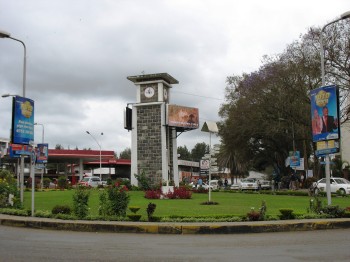
This report has been put together by gathering and accumulating pertinent information for a while.
What we know for certain is it all began after the 1800s when Ismailis from Kutch and Kathiwar in Gujarat, India, ventured to the unknown and unexplored continent to begin a new life in East Africa.
Many Ismailis settled in Tanzania, formerly Tanganyika, after the country was put under British administration following the defeat of Germany, which had formerly ruled the territory.

Sultan Mohamed Shah visiting Arusha.It was under the leadership of Sir Sultan Mohamed Shah that Ismailis left Gujarat and other regions of India in large numbers in search of better economic opportunities as traders and merchants in unknown and unexplored Africa.
Being friends with and extremely close to the British raj, Aga Khan III, was one of the first world leaders to anticipate the scramble for Africa on the part of the European Imperial powers and the economic opportunities that would follow.
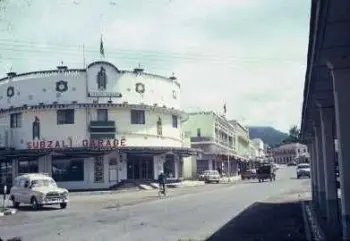
GetAtta11chment
The Aga Khan’s vision was that his dedicated and devoted followers will be at the forefront of economic development to transform the lives of ordinary people who had long suffered slavery, servitude and abject poverty.
A series of devastating famines in India and plentiful employment opportunities in Kenya, Uganda, Tanzania and other African countries prompted a huge exodus from India.
Apart from famine, there was high unemployment, religious persecution and political instability in India at the time.
hazar imam visiting aga khan school in arusha

Ismailis travelled by dhows and initially settled in coastal areas like Zanzibar, Dar es Salaam and Mombasa and then gradually made their way to the mainland.
Arusha, sprawling near the foot of Mount Meru, was cool, lush and green. This was a big appeal to many new settlers.
The Ismailis were shrewd and competent traders and enterprising merchant.
They promptly established themselves as the pioneering Asian group and made special efforts to assert their distinctiveness from other communities.
ismaili women volunteers in arusha
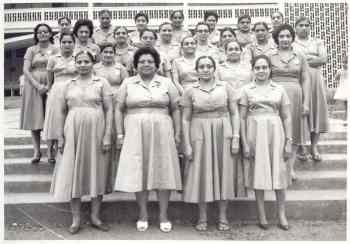
Unlike other ethnic groups, the Ismailis were more adaptable and brought their womenfolk.
Their intentions were to settle permanently which gave them an important commercial advantage.
After settling smoothly and establishing themselves, the Ismailis pushed for separate burial grounds.
They were also successful establishing Ismaili schools, dispensaries and hospitals which were open to everyone regardless of their race, colour, creed or caste.
all arusha pictures 076

This is the way it was and even today it is a religious duty and obligation to be loyal citizens of whatever country they live in.
The existence of a living Imam has meant the Ismailis have been more flexible in adjusting to rapidly changing and evolving conditions in the last century.
A letter, written on April 12, 1955 by Robert Gray to the Institute of Current World Affairs in New York, talks about the early Ismaili settlement.
Gray fondly wrote about visiting Indian traders and other villagers.
According to him, the small retail trade of Tanganyika was almost exclusively in the hands of Indian traders.
All Arusha pictures 418
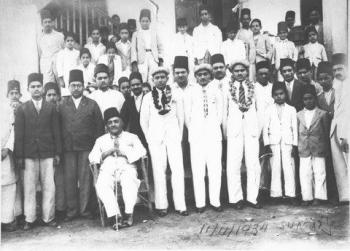
Some of these commercial families had become quite wealthy and possessed modern town houses and gave their children the best of education available at the time.
“But, in almost every case, their origins were humble,” Gray wrote.
The Ismaili settlement rapidly increased in numbers and wealth in mid 1930s.
The Aga Khan School and other institutions were established in Arusha.
A small Jamat Khana (prayer house) was built and many years later replaced by an ultramodern building.
hazar imam in arusha
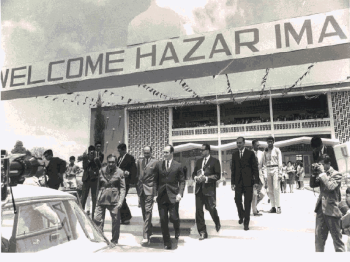
At one time, there were as many as 900 Ismailis living, working and doing business in Arusha.
Today, the number has dwindled to less than 300.
But, many new immigrants continue to arrive from India and Pakistan.
Ismailis prospered in Arusha and many owned large businesses.
Many did quite well in their chosen professions after getting their higher education in universities in Europe and America.
A few played significant roles in the day to day running of the community.
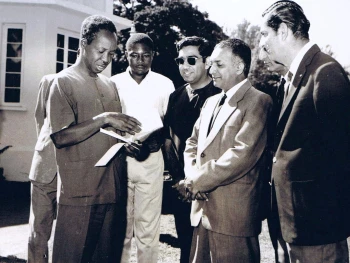
Several became quite wealthy and contributed some of their wealth to charitable projects.
Arusha originally grew up as a German colonial town at the beginning of the 20 century.
Due to its pleasant climate and fertile soil, Arusha was an ideal respite from the humid malarial conditions of the coast and a great place to grow coffee and other crops.
After the Second World War, it shifted into British hands, retaining its colonial feel with a growing population and luxuries like golf courses and private clubs.
Since independence in 1961, Arusha has contrived to grow at a rapid pace.
It is a magnate for Tanzanians seeking their fortune in the Tanzanite mining areas and of course lured by the riches of the safari industry.
It had today become one of the most economically important cities in Tanzania.
When I grew up in Arusha, the population was around 35, 0000 inhabitants.
Some of the most prominent Ismaili families in Arusha then were Natha Hirji, Subzali Sajan, Nurmohamed Velshi Gilani, Moosa Janmohamed, brothers Kanji , Hassanali, Jamal, and Ebrahim Mohamed among many others.
Somewhere among them but not prominent was my family which thrived and prospered in Arusha running a coffee farm and a bakery.
Two other Ismaili families who also owned bakeries then were Abdulla Alimohaned and Gulam Haider.
Arusha’s population ha s now mushroomed to a staggering 500,000 people.
The Aga Khan is investing more than $1.1billion over the next several years to a fullyfledged university.
This is the largest investment in higher education in the history of the region.
Arusha is the headquarters of the East African community, host to the International Crime Tribunal for Rwanda and the African Court on Human Rights.
This is not the complete report. There are sections missing. We will be interested to hear from you as well. We will also welcome memorable photographs from you. They can be sent to [email protected].
Attempts are currently in process to write a similar story about Ismaili settlements in Moshi, which was to be the headquarters of our Aga Khan regional council.
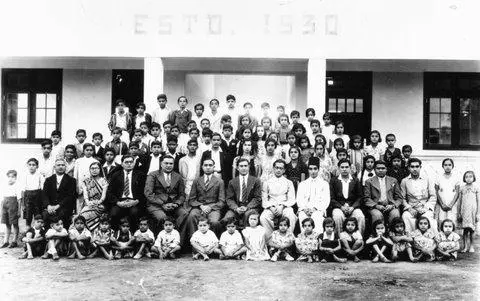
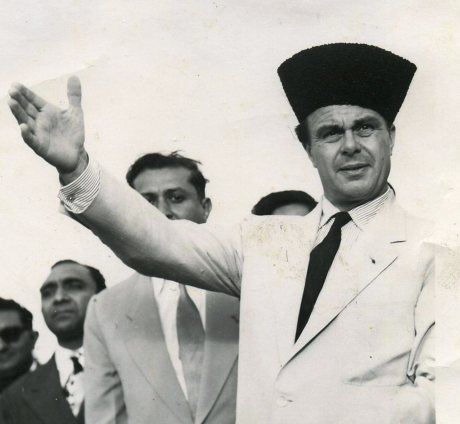
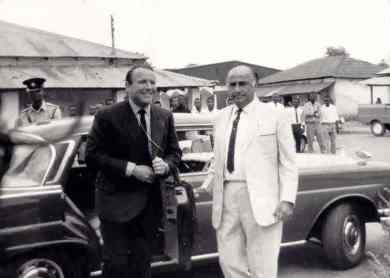


/ismailimail.blog/2015/06/10/early-ismaili-settlement-in-arusha/
BY ISMAILIMAIL POSTED ON JUNE 10, 2015
Early Ismaili settlement in Arusha,
Tanzania
BY SULTAN JESSA
Information on when and where Ismailis, followers of their spiritual leader the Aga Khan, came from to begin new settlement in the northern Tanzania town of Arusha is hard to come by.
Unless immediate steps are taken our early history may be lost forever.
clock tower

This report has been put together by gathering and accumulating pertinent information for a while.
What we know for certain is it all began after the 1800s when Ismailis from Kutch and Kathiwar in Gujarat, India, ventured to the unknown and unexplored continent to begin a new life in East Africa.
Many Ismailis settled in Tanzania, formerly Tanganyika, after the country was put under British administration following the defeat of Germany, which had formerly ruled the territory.

Sultan Mohamed Shah visiting Arusha.It was under the leadership of Sir Sultan Mohamed Shah that Ismailis left Gujarat and other regions of India in large numbers in search of better economic opportunities as traders and merchants in unknown and unexplored Africa.
Being friends with and extremely close to the British raj, Aga Khan III, was one of the first world leaders to anticipate the scramble for Africa on the part of the European Imperial powers and the economic opportunities that would follow.

GetAtta11chment
The Aga Khan’s vision was that his dedicated and devoted followers will be at the forefront of economic development to transform the lives of ordinary people who had long suffered slavery, servitude and abject poverty.
A series of devastating famines in India and plentiful employment opportunities in Kenya, Uganda, Tanzania and other African countries prompted a huge exodus from India.
Apart from famine, there was high unemployment, religious persecution and political instability in India at the time.
hazar imam visiting aga khan school in arusha

Ismailis travelled by dhows and initially settled in coastal areas like Zanzibar, Dar es Salaam and Mombasa and then gradually made their way to the mainland.
Arusha, sprawling near the foot of Mount Meru, was cool, lush and green. This was a big appeal to many new settlers.
The Ismailis were shrewd and competent traders and enterprising merchant.
They promptly established themselves as the pioneering Asian group and made special efforts to assert their distinctiveness from other communities.
ismaili women volunteers in arusha

Unlike other ethnic groups, the Ismailis were more adaptable and brought their womenfolk.
Their intentions were to settle permanently which gave them an important commercial advantage.
After settling smoothly and establishing themselves, the Ismailis pushed for separate burial grounds.
They were also successful establishing Ismaili schools, dispensaries and hospitals which were open to everyone regardless of their race, colour, creed or caste.
all arusha pictures 076

This is the way it was and even today it is a religious duty and obligation to be loyal citizens of whatever country they live in.
The existence of a living Imam has meant the Ismailis have been more flexible in adjusting to rapidly changing and evolving conditions in the last century.
A letter, written on April 12, 1955 by Robert Gray to the Institute of Current World Affairs in New York, talks about the early Ismaili settlement.
Gray fondly wrote about visiting Indian traders and other villagers.
According to him, the small retail trade of Tanganyika was almost exclusively in the hands of Indian traders.
All Arusha pictures 418

Some of these commercial families had become quite wealthy and possessed modern town houses and gave their children the best of education available at the time.
“But, in almost every case, their origins were humble,” Gray wrote.
The Ismaili settlement rapidly increased in numbers and wealth in mid 1930s.
The Aga Khan School and other institutions were established in Arusha.
A small Jamat Khana (prayer house) was built and many years later replaced by an ultramodern building.
hazar imam in arusha

At one time, there were as many as 900 Ismailis living, working and doing business in Arusha.
Today, the number has dwindled to less than 300.
But, many new immigrants continue to arrive from India and Pakistan.
Ismailis prospered in Arusha and many owned large businesses.
Many did quite well in their chosen professions after getting their higher education in universities in Europe and America.
A few played significant roles in the day to day running of the community.

Several became quite wealthy and contributed some of their wealth to charitable projects.
Arusha originally grew up as a German colonial town at the beginning of the 20 century.
Due to its pleasant climate and fertile soil, Arusha was an ideal respite from the humid malarial conditions of the coast and a great place to grow coffee and other crops.
After the Second World War, it shifted into British hands, retaining its colonial feel with a growing population and luxuries like golf courses and private clubs.
Since independence in 1961, Arusha has contrived to grow at a rapid pace.
It is a magnate for Tanzanians seeking their fortune in the Tanzanite mining areas and of course lured by the riches of the safari industry.
It had today become one of the most economically important cities in Tanzania.
When I grew up in Arusha, the population was around 35, 0000 inhabitants.
Some of the most prominent Ismaili families in Arusha then were Natha Hirji, Subzali Sajan, Nurmohamed Velshi Gilani, Moosa Janmohamed, brothers Kanji , Hassanali, Jamal, and Ebrahim Mohamed among many others.
Somewhere among them but not prominent was my family which thrived and prospered in Arusha running a coffee farm and a bakery.
Two other Ismaili families who also owned bakeries then were Abdulla Alimohaned and Gulam Haider.
Arusha’s population ha s now mushroomed to a staggering 500,000 people.
The Aga Khan is investing more than $1.1billion over the next several years to a fullyfledged university.
This is the largest investment in higher education in the history of the region.
Arusha is the headquarters of the East African community, host to the International Crime Tribunal for Rwanda and the African Court on Human Rights.
This is not the complete report. There are sections missing. We will be interested to hear from you as well. We will also welcome memorable photographs from you. They can be sent to [email protected].
Attempts are currently in process to write a similar story about Ismaili settlements in Moshi, which was to be the headquarters of our Aga Khan regional council.





/ismailimail.blog/2015/06/10/early-ismaili-settlement-in-arusha/
Ismaili Settlement in Moshi, Tanzania
BY ISMAILIMAIL POSTED ON JULY 7, 2015
Early Ismaili settlers found Moshi, nestling on the slopes of the mighty Kilimanjaro, offered a lot of potential and employment opportunities!
BY SULTAN JESSA
EDITOR’S NOTE: Retired Canadian journalist, Sultan Jessa, who was born in Moshi, takes a look at the early Ismaili settlement in the northern Tanzanian town. “I expected this to be an easy task,” he admits. “I contacted many Ismailis but the poor response was not what I expected.” This is an initial attempt. It is quite possible that history and contributions of some Ismailis have been missed in this feature. Hopefully this important part of our past history can be updated at at later date. Please submit your comments, photographs and other pertinent information you feel is important and should be included to the Ismailimail or to Sultan at [email protected]. We have deliberately refrained from naming people in several photographs for fear of not properly identifying them or misspelling names which can be very annoying.
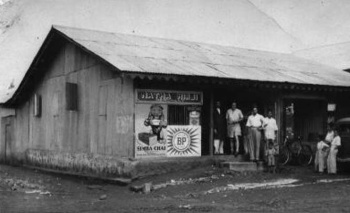
Ismaili Settlement in Moshi
MONTREAL – Canada: Portuguese explorer Vasco da Gama visited many areas of Africa during his voyage of expedition in 1498.
Mombasa, Malindi, Dar es Salaam and Zanzibar in East Africa and Mozambique were among places he visited and explored.
It is almost certain there were Ismailis among the Muslims who traded in rice, sesame seeds, oil, cotton, wool, animal hide and other things.
Islam was brought to the East African coast by explorers and traders from the Arab peninsula and Muslim civilization began to flourish.

Sultan Mohamed Shah in Moshi
Ismailis from Sindh, Kutch, Kathiawar and other parts of Gujarat left the Indian sub continent following the severe drought of 1799.
Their primary objective was to seek employment opportunities and better prospects for their children.
Ismailis, who were given freedom of religion and protection, initially settled in coastal area and gradually started moving to the hinterland in Tanzania and started establishing places of worship.
There is no credible record of early Ismaili settlement particularly in northern Tanzania (then Tanganyika) because our ancestors did not write much and often signed their names with their thumbs.
Sir Sultan Mohamed Shah, grandfather of the present Imam, played a pivotal role in encouraging Ismailis to seek better economic opportunities when the scramble for Africa was on.

Sultan Mohamed Shah at the Moshi Airport
No one is sure who the first Ismaili to settle in Moshi before Tanganyika switched from being under German rule to British.
However, it is it is widely known and accepted that Joherali Jamal, with a few other Indians, was already doing business in Moshi during the German rule.
Initially the Indians were suspected of being German spies but once when they were cleared of all allegations, they were awarded land.
Jamal lived in a corrugated iron home which he converted into a double storey building on Mawenzi Road.

Ismaili Settlement in Moshi
“My father, accompanied by grandparents, came to Africa in 1906,” recalls Jimmy Moolji. “He was only 11 years old.”
The Moolji Nazarali family was among other pioneers.
His father’s elder brother, Alibhai Nazarali came to East Africa a little earlier and settled at a place called Sultan Hamud near Eldoret in Kenya. His mission was to pave way for settling the rest of family members.
Moolji (Jimmy) also recalls as school was not an option, his father started hawking food prepared by his grandmother.

Moshi Jamatkhana
A few years later his father was betrothed to his mother who was born in Dar es Salaam but had become orphans and lived with close relatives in Voi not too far from Moshi.
He eventually moved to Voi and started working in the sisal estate with his in-laws.
The Moolji family made a fortune in business and later decided to return to Moshi with his small family at the time the Ismaili population was on the rapid rise. Jimmy (Moolji) said his father and others built the town’s first Jamat Khana at a cost of 25,000 shillings.
The fund raising campaign was not going well because of hard times.

Kassamali Jamal With His Highness the Aga Khan III
This was when the Moolji family decided to pay for the entire cost for the Jamat Khana and later built a library, a guest house and a nursery school.
Moolji died in 1936 and to honour his memory and legacy, a clock tower was built in a traffic circle which is still in existence today.
He was also instrumental in building the Aga Khan Primary School.
The distinguished Natha Hirji family migrated to East Africa around 1910.
Mahmoud Hirji, son of late Kasamali Hirji, the former president of Aga Khan Council in Moshi, provided some information for the early settlement. He made it clear most of the information is based on hearsay and anecdotes.

Kassamali Jamal left and Hassanali Babu Kurji Kanji with the Noorani Family
“I cannot corroborate any of it,” he stressed.
Natha Hirji moved to East Africa around 1910 as a young man and first landed in Mombasa where he, like many new immigrants, found employment within the Allidina Visram empire.
In 1912, Hirji and a four other Ismailis, travelled inland to Moshi seek their fortunes and settle there.
Of the five Ismaili pioneers, two of them quickly established themselves as successful businessmen and leaders of the community.
It is not known who the other three were.

Prince Alykhan visit to Moshi
They were the Hirji and Nazarali (Moolji) families and assisted many Ismailis to settle in the town or to learn business dealings from them and eventually moved to Nairobi, Kampala and the Congo.
When the first World War broke out in 1914, Hirji and other Ismaili families returned to India and only returned at end of the war.
The Hirji family began to establish a dynasty. Hirji established a sole distributorship with the British American Tobacco (BAT).
Due to his legendary honesty and ethics, Hirji refused to market tobacco in the black market due to universal shortages, and resisted the chance and opportunity to become an overnight millionaire.

Prince Alykhan welcome in Moshi
A group of Brits tried to wrestle the BAT distributorship away from the family, complaining to the government about “Indians” being allowed the distributorship.
The frustrated and unhappy Brits eventually lost because BAT recognized the integrity and of the Hirjis.
Several other attempts by the British rednecks also failed.
One was to buy inferior South African brand tobacco and attempting to boycott the “Indians.”
The Brits were once again openly buying cigarettes and other tobacco products from the Hirji family and could not stand the the South African products marketing under the brand name of upstarts.

Ismaili Settlement in Moshi
This company admitted defeat, packed up and left Moshi.
“This is a sweet story of honesty triumphing against the forces of racism and evil,” Hirji (Mahmoud) said. “This is what I remember from stories told to us.”
The Hirji family, apart from BAT distributorship, also operated other businesses in Moshi and neighbouring Arusha, including Coca Cola Bottling, Unga Limited, Brooke Bond Tea as well as Plaza and Palladium cinemas.
The late Mohamedali Natha Hirji was nominated and appointed Member of Parliament by the Tanganyika African National Union (TANU) soon after independence.

Natha Hirji Family members
He also served as the deputy mayor of Moshi.
Information is hard to get details on other families that left a mark on Moshi.
Another well known family was Hasham Jessa.
My grandfather was born in Jamkandana near Junagadh in Gujarat in 1898. Accompanied by his wife Sambai (Virji Amershi), he moved to Moshi from Mombasa and set up a duka (shop) at Himo.
He later started a bee-keeping and honey business and gradually expanded his mushrooming business empire to include a cattle and fruit farm in Ngare Nairobi and constructed a multi-storey building – Tanganyika House – opposite the Kilimanjaro Native Co-operative Union.
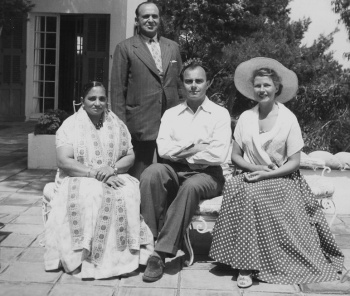
Prince Aly Khan, Rita Hayworth, with Mr and Mrs Moolji Nazarali
Jessa was a shrewd businessman who sold fruits, mainly oranges and tangerine and vegetables from his farm in west Kilimanjaro to Nairobi.
Behind this successful man was his wife Sambai, who despite having limited education, was a real power house in negotiating lucrative deals with banks and businesses.
Other families whose names cropped up in discussions with former Moshi residents include Hassanali Valji Kassam, Kasamali Jamal Habib, Hassanali Charania, Gulamsein Jiwa, Merali Hirji, Gulamsein Hasham Lalani, Hassanali Kassam Virani, Alibhai Amersi, Popat Rajan, Nurmohamed Dadani, Kurji Kanji, Nazarali walji, Kanji Raattansi, Habib Hirji, Devsi Kassam, Pyarali Kachra, Ramzan Bundali and many, many more.
When Moshi was enjoying a boom time, it was the headquarters of northern Taanzania’s Ismaili council and more than 1,500 Ismailis lived there.
Today, the Ismaili population has dwindled to less than 50.
Moshi, meaning smoke in Swahili, obtained its name from smoke wisps still visible and emitting from the near-extinct crater of Mount Kilimanjaro, the 19,340-foot mountain.
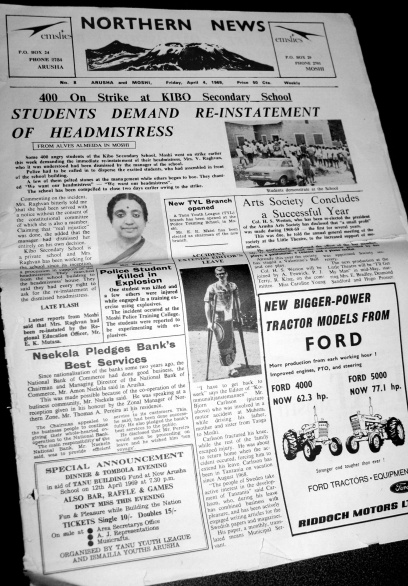



Hasham Jessa and his wife Sambai

Leaders Conference in Nairobi

Merali Hirji and his son Mahdi with Aga Khan III

Moolji Nazarali at Avian Conference France

Moolji Nazarali FamilyIsmaili
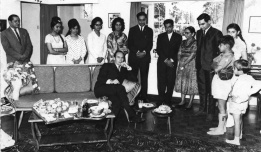
Settlement in Moshi
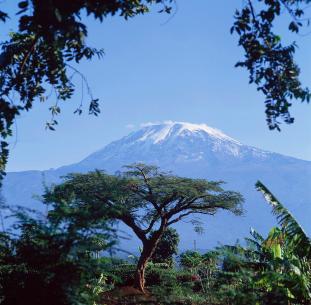
Mt. Kilimanjaro Moshi, Tanzania - David Constantine

https://ismailimail.blog/2015/07/07/ism ... -tanzania/
BY ISMAILIMAIL POSTED ON JULY 7, 2015
Early Ismaili settlers found Moshi, nestling on the slopes of the mighty Kilimanjaro, offered a lot of potential and employment opportunities!
BY SULTAN JESSA
EDITOR’S NOTE: Retired Canadian journalist, Sultan Jessa, who was born in Moshi, takes a look at the early Ismaili settlement in the northern Tanzanian town. “I expected this to be an easy task,” he admits. “I contacted many Ismailis but the poor response was not what I expected.” This is an initial attempt. It is quite possible that history and contributions of some Ismailis have been missed in this feature. Hopefully this important part of our past history can be updated at at later date. Please submit your comments, photographs and other pertinent information you feel is important and should be included to the Ismailimail or to Sultan at [email protected]. We have deliberately refrained from naming people in several photographs for fear of not properly identifying them or misspelling names which can be very annoying.

Ismaili Settlement in Moshi
MONTREAL – Canada: Portuguese explorer Vasco da Gama visited many areas of Africa during his voyage of expedition in 1498.
Mombasa, Malindi, Dar es Salaam and Zanzibar in East Africa and Mozambique were among places he visited and explored.
It is almost certain there were Ismailis among the Muslims who traded in rice, sesame seeds, oil, cotton, wool, animal hide and other things.
Islam was brought to the East African coast by explorers and traders from the Arab peninsula and Muslim civilization began to flourish.

Sultan Mohamed Shah in Moshi
Ismailis from Sindh, Kutch, Kathiawar and other parts of Gujarat left the Indian sub continent following the severe drought of 1799.
Their primary objective was to seek employment opportunities and better prospects for their children.
Ismailis, who were given freedom of religion and protection, initially settled in coastal area and gradually started moving to the hinterland in Tanzania and started establishing places of worship.
There is no credible record of early Ismaili settlement particularly in northern Tanzania (then Tanganyika) because our ancestors did not write much and often signed their names with their thumbs.
Sir Sultan Mohamed Shah, grandfather of the present Imam, played a pivotal role in encouraging Ismailis to seek better economic opportunities when the scramble for Africa was on.

Sultan Mohamed Shah at the Moshi Airport
No one is sure who the first Ismaili to settle in Moshi before Tanganyika switched from being under German rule to British.
However, it is it is widely known and accepted that Joherali Jamal, with a few other Indians, was already doing business in Moshi during the German rule.
Initially the Indians were suspected of being German spies but once when they were cleared of all allegations, they were awarded land.
Jamal lived in a corrugated iron home which he converted into a double storey building on Mawenzi Road.

Ismaili Settlement in Moshi
“My father, accompanied by grandparents, came to Africa in 1906,” recalls Jimmy Moolji. “He was only 11 years old.”
The Moolji Nazarali family was among other pioneers.
His father’s elder brother, Alibhai Nazarali came to East Africa a little earlier and settled at a place called Sultan Hamud near Eldoret in Kenya. His mission was to pave way for settling the rest of family members.
Moolji (Jimmy) also recalls as school was not an option, his father started hawking food prepared by his grandmother.

Moshi Jamatkhana
A few years later his father was betrothed to his mother who was born in Dar es Salaam but had become orphans and lived with close relatives in Voi not too far from Moshi.
He eventually moved to Voi and started working in the sisal estate with his in-laws.
The Moolji family made a fortune in business and later decided to return to Moshi with his small family at the time the Ismaili population was on the rapid rise. Jimmy (Moolji) said his father and others built the town’s first Jamat Khana at a cost of 25,000 shillings.
The fund raising campaign was not going well because of hard times.

Kassamali Jamal With His Highness the Aga Khan III
This was when the Moolji family decided to pay for the entire cost for the Jamat Khana and later built a library, a guest house and a nursery school.
Moolji died in 1936 and to honour his memory and legacy, a clock tower was built in a traffic circle which is still in existence today.
He was also instrumental in building the Aga Khan Primary School.
The distinguished Natha Hirji family migrated to East Africa around 1910.
Mahmoud Hirji, son of late Kasamali Hirji, the former president of Aga Khan Council in Moshi, provided some information for the early settlement. He made it clear most of the information is based on hearsay and anecdotes.

Kassamali Jamal left and Hassanali Babu Kurji Kanji with the Noorani Family
“I cannot corroborate any of it,” he stressed.
Natha Hirji moved to East Africa around 1910 as a young man and first landed in Mombasa where he, like many new immigrants, found employment within the Allidina Visram empire.
In 1912, Hirji and a four other Ismailis, travelled inland to Moshi seek their fortunes and settle there.
Of the five Ismaili pioneers, two of them quickly established themselves as successful businessmen and leaders of the community.
It is not known who the other three were.

Prince Alykhan visit to Moshi
They were the Hirji and Nazarali (Moolji) families and assisted many Ismailis to settle in the town or to learn business dealings from them and eventually moved to Nairobi, Kampala and the Congo.
When the first World War broke out in 1914, Hirji and other Ismaili families returned to India and only returned at end of the war.
The Hirji family began to establish a dynasty. Hirji established a sole distributorship with the British American Tobacco (BAT).
Due to his legendary honesty and ethics, Hirji refused to market tobacco in the black market due to universal shortages, and resisted the chance and opportunity to become an overnight millionaire.

Prince Alykhan welcome in Moshi
A group of Brits tried to wrestle the BAT distributorship away from the family, complaining to the government about “Indians” being allowed the distributorship.
The frustrated and unhappy Brits eventually lost because BAT recognized the integrity and of the Hirjis.
Several other attempts by the British rednecks also failed.
One was to buy inferior South African brand tobacco and attempting to boycott the “Indians.”
The Brits were once again openly buying cigarettes and other tobacco products from the Hirji family and could not stand the the South African products marketing under the brand name of upstarts.

Ismaili Settlement in Moshi
This company admitted defeat, packed up and left Moshi.
“This is a sweet story of honesty triumphing against the forces of racism and evil,” Hirji (Mahmoud) said. “This is what I remember from stories told to us.”
The Hirji family, apart from BAT distributorship, also operated other businesses in Moshi and neighbouring Arusha, including Coca Cola Bottling, Unga Limited, Brooke Bond Tea as well as Plaza and Palladium cinemas.
The late Mohamedali Natha Hirji was nominated and appointed Member of Parliament by the Tanganyika African National Union (TANU) soon after independence.

Natha Hirji Family members
He also served as the deputy mayor of Moshi.
Information is hard to get details on other families that left a mark on Moshi.
Another well known family was Hasham Jessa.
My grandfather was born in Jamkandana near Junagadh in Gujarat in 1898. Accompanied by his wife Sambai (Virji Amershi), he moved to Moshi from Mombasa and set up a duka (shop) at Himo.
He later started a bee-keeping and honey business and gradually expanded his mushrooming business empire to include a cattle and fruit farm in Ngare Nairobi and constructed a multi-storey building – Tanganyika House – opposite the Kilimanjaro Native Co-operative Union.

Prince Aly Khan, Rita Hayworth, with Mr and Mrs Moolji Nazarali
Jessa was a shrewd businessman who sold fruits, mainly oranges and tangerine and vegetables from his farm in west Kilimanjaro to Nairobi.
Behind this successful man was his wife Sambai, who despite having limited education, was a real power house in negotiating lucrative deals with banks and businesses.
Other families whose names cropped up in discussions with former Moshi residents include Hassanali Valji Kassam, Kasamali Jamal Habib, Hassanali Charania, Gulamsein Jiwa, Merali Hirji, Gulamsein Hasham Lalani, Hassanali Kassam Virani, Alibhai Amersi, Popat Rajan, Nurmohamed Dadani, Kurji Kanji, Nazarali walji, Kanji Raattansi, Habib Hirji, Devsi Kassam, Pyarali Kachra, Ramzan Bundali and many, many more.
When Moshi was enjoying a boom time, it was the headquarters of northern Taanzania’s Ismaili council and more than 1,500 Ismailis lived there.
Today, the Ismaili population has dwindled to less than 50.
Moshi, meaning smoke in Swahili, obtained its name from smoke wisps still visible and emitting from the near-extinct crater of Mount Kilimanjaro, the 19,340-foot mountain.




Hasham Jessa and his wife Sambai

Leaders Conference in Nairobi

Merali Hirji and his son Mahdi with Aga Khan III

Moolji Nazarali at Avian Conference France

Moolji Nazarali FamilyIsmaili

Settlement in Moshi

Mt. Kilimanjaro Moshi, Tanzania - David Constantine

https://ismailimail.blog/2015/07/07/ism ... -tanzania/
Ismaili Jamat in Kisumu - 3 generations from Aga Khan Family
Ismaili Jamat in Kisumu - 3 generations from Nurani Family: Aga Khan III, Prince Aly Khan and Aga Khan IV
KISUMU JAMAT was amongst they most prominent African Ismaili community in the 20th Century. The Imam Mowlana Shah Karim AGA KHAN IV visited Kisumu many times. The present Imam made half a dozen historical visits in 1959 when he had a Mulakat with Students, 1966, 1976, March 1981 when he gave Didat to the Jamat and Mulakat to the students, 1985 etc.. in 1966 the Imam spent 3 days there and gave didar on 8th and 10th of December. On 9 December 1966, at Kisumu, Mowlana Hazar Imam laid the foundation stone of a bottling plant and attended a reception at the Town Hall. At Kisii, he had lunch with two Ministers, Mr. Lawrence Sagini and Mr. James Nyamweya. On 23rd May 1966, he had already sent a message from Marseille with Blessing for offering of the new Takht (Throne) for Jamatkhana and said "It will not be long till I can admire it. Sure enough, he came and sat on that Takhat! In term of social and religious programs for the Jamat, Kisumu leadership was at the forefront. It was the first Jamat to produce Ginan Mushaedo on a disk (45 RPM at that time). The Jamat had great Philanthropists such as Alijah Janmohamed Hasham "Kisumuwallah" and even politicians such as Mohamed Kassum Lakha who became Member of the Legislative Council of Kenya, he also contributed towards building the Kisumu Jamatkhana. If you have roots in Kisumu or have photos of various Noorani Family visitsWe are sharing here some historical photos with dates or names of people when they could be found. Enjoy!
PHOTO 1: Aga Khan III, Mowlana Sultan Muhammad Shah in Kisumu in 1937 with Fazal Alibhai Lakha, Rahamatallah Kassim Lakha, Mukhi Mawji Esmail and Council President Hasham Jamal
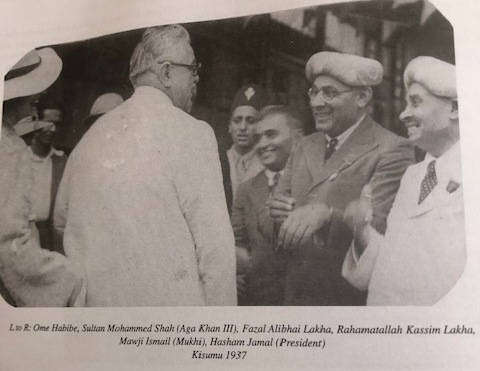
PHOTO 2: Aga Khan III in Kisumu in 1945. Surrounded by Khatija, Shahbanu behind the window, Gulshan, Guly, Ebrahim (With his head down), Sikina, Amir Shamji all behind Aga Khan III, Mowlana Sultan Muhammad Shah. Please post names of the lady and gentleman by Mowla's side in the comment.

PHOTO 3: Aga Khan IV in Kisumu in May 1961 when Gichuru hosted the dinner at Habib Keshavjees home. The sofa was blue and the coffee table was from Murad’s furniture brought from South Africa. Zarina was asked to help her sister Guli Nazarali Manji Keshavjee to decorate the house for the event .
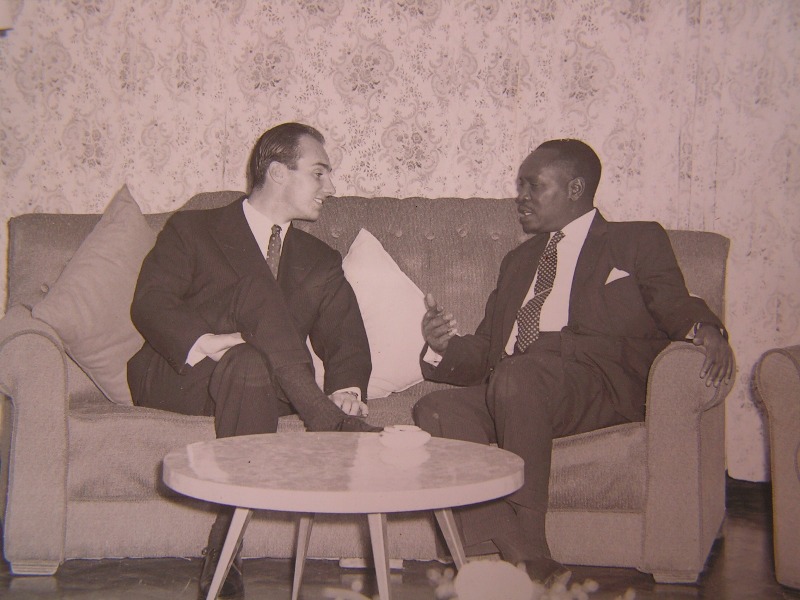
PHOTO 4: 1981 Mowlana Hazar Imam welcomes at the Aga Khan Primary School by Headmistress Roshan Tejpar. Alwaez Qaim Subzali in the back.

PHOTO 5: Mowlana Shah Karim in Kisumu in the 1957 The little girl sitting at the desk is Parviz Fazal.
Headmistress of that time was Mrs Owen, the wife of the policeman Peter Owen. It is said that she was a very good headmistress. After 1959 Miss Owen left. She was replaced by Mrs Mascarhnas
The AK Primary School was near the Aga Khan Dispensary. Shirin Samji (Keshavjee) helped to turn it into a Maternity Hospital, She was a qualified midwife from Pretoria. Shirin Cassam Keshavjee married Amir Samji. Amir Samji ‘s mother was Hirbai Jamal.
The Story of Shirin: Shirin Cassam Keshavjee was inspired by the 48th Imam’s farman. She joined Witwatersrand University (Whits), South Africa, to train as a nurse and then as a midwife. However she could not practice nursing near her home, being a person of colour. Fortunately for Shirin, she heard an announcement in the Pretoria Jamatkhana that they were looking to employ a nurse in the Aga Khan Clinic in Kisumu. Lucky for Shirin, her uncle, Habib Keshavjee, was off to East Africa with his family. So Shirin joined Habib Keshavjee’s family for the trip. She came to Nairobi and proceeded to Kisumu to live with the family of Count Hasham Jamal. Here Shirin was to change the face of midwifery in the Nyanza District. She was the first ever qualified midwife. She was appalled at the state of the women and the new born child. Her kind hearted and soft spoken manner brought mothers from all over the district of Nyanza, Homa Bay, Kindu Bay, Kissii, Kimlili, and all the way from Kampala too! She explained early care of the child, sanitation, breast feeding, sterilization, diet of mother and child. Shirin then married Amir Shamji. Thus began the liaison. Now there are five Keshavjees, married to five Jamals!! Shirin Shamji (nee Keshavjee) lives in Toronto.
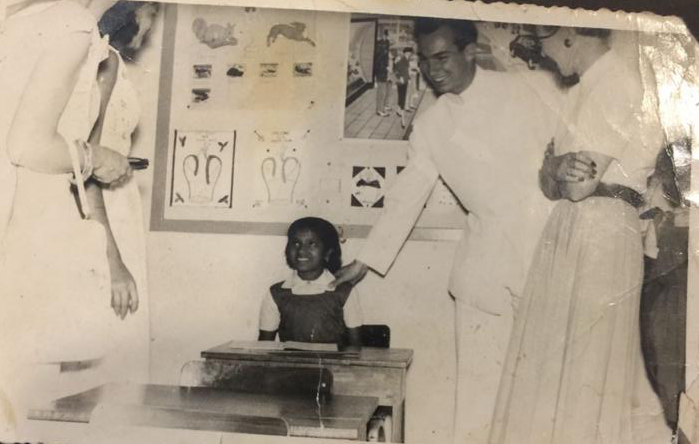
PHOTO 6: Prince Aly Khan and Princess Tajudaulah, parents of Mowlana Hazar Imam Aga Khan IV visiting Kisumu Jamat (Date unknown)
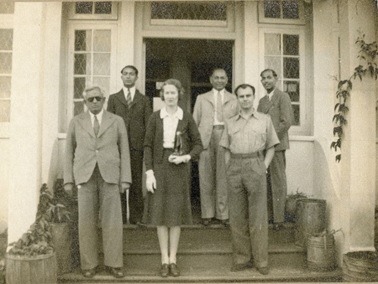
PHOTO 7: Aga Khan IV in Kisumu, looks like 1966, if you know the person on this photo, please share. The person in white jacket is Mukhi Sadru Punjani, his brother Mohamed Punjani was the first Mukhi of Darkhana Burnaby Jamatkhana when the community established itself in Canada. Standing near MOwlana Hazar Imam is Ali Juma Ahmed , next standing is Aziz musa Ramji. Sitting near Mowlana Hazar Imam in the right is Sadru Hassam Saudin.
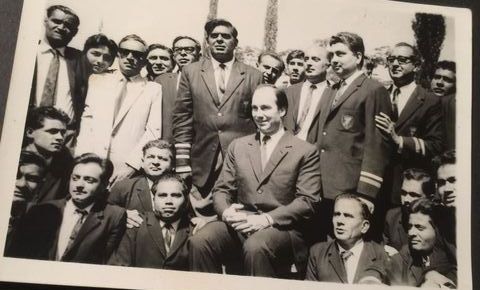
PHOTO 8: On a lighter note, February 1976, Mowlana Hazar Imam and Begum Salimah dancing at the Kisumu Aga Khan Club

PHOTO 9: Mowlana Hazar Imam in Kisumu early 1960s' - Aga Khan IV with on the Right: Roshy Charania, Left Nazira Bhanji, Behind Nazira is Shama and behind Shama is Azee. At the feet of Mowla the aged woman is Rrabhia Lahiri then Ashraf on Mowla's Left is Yasmin Fazal , they were staying at kibuye Ismailia flats.
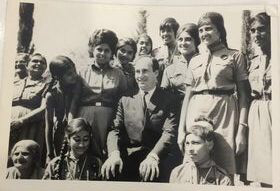
PHOTO 10: Mohamed Kassum Lakha who became Member of the Legislative Council of Kenya

PHOTO 11: Alijah Janmohamed Hasham "Kisumuwallah"
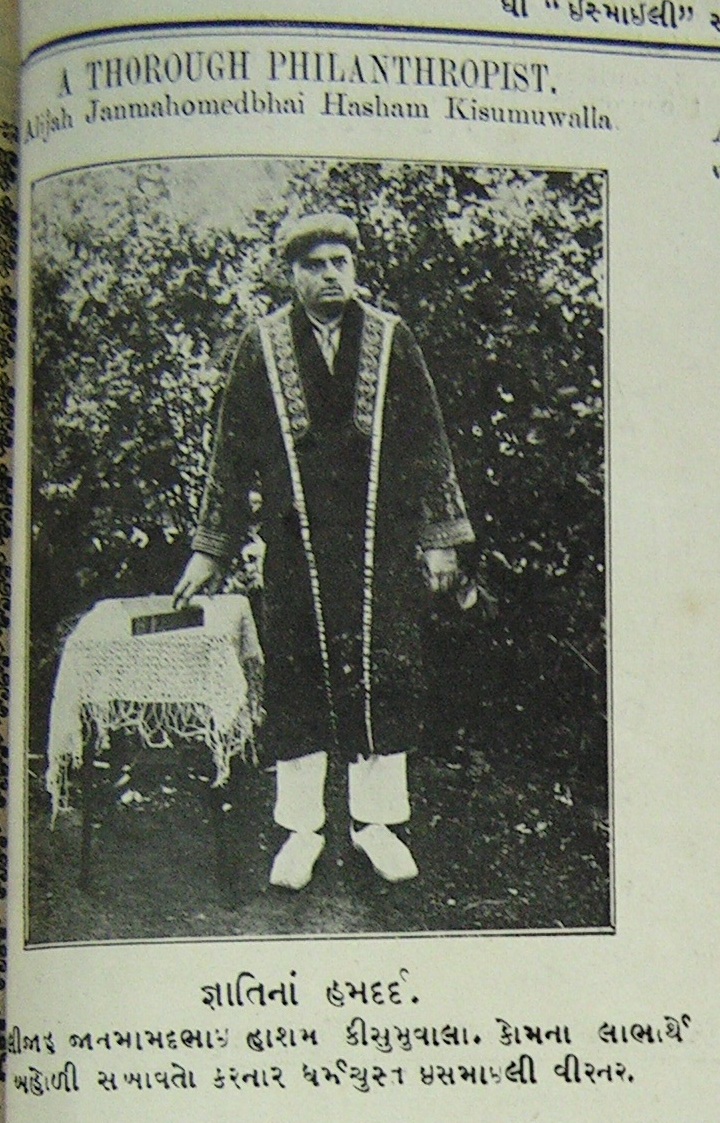
Thanks to all Kisumu people who contributed the information.
KISUMU JAMAT was amongst they most prominent African Ismaili community in the 20th Century. The Imam Mowlana Shah Karim AGA KHAN IV visited Kisumu many times. The present Imam made half a dozen historical visits in 1959 when he had a Mulakat with Students, 1966, 1976, March 1981 when he gave Didat to the Jamat and Mulakat to the students, 1985 etc.. in 1966 the Imam spent 3 days there and gave didar on 8th and 10th of December. On 9 December 1966, at Kisumu, Mowlana Hazar Imam laid the foundation stone of a bottling plant and attended a reception at the Town Hall. At Kisii, he had lunch with two Ministers, Mr. Lawrence Sagini and Mr. James Nyamweya. On 23rd May 1966, he had already sent a message from Marseille with Blessing for offering of the new Takht (Throne) for Jamatkhana and said "It will not be long till I can admire it. Sure enough, he came and sat on that Takhat! In term of social and religious programs for the Jamat, Kisumu leadership was at the forefront. It was the first Jamat to produce Ginan Mushaedo on a disk (45 RPM at that time). The Jamat had great Philanthropists such as Alijah Janmohamed Hasham "Kisumuwallah" and even politicians such as Mohamed Kassum Lakha who became Member of the Legislative Council of Kenya, he also contributed towards building the Kisumu Jamatkhana. If you have roots in Kisumu or have photos of various Noorani Family visitsWe are sharing here some historical photos with dates or names of people when they could be found. Enjoy!
PHOTO 1: Aga Khan III, Mowlana Sultan Muhammad Shah in Kisumu in 1937 with Fazal Alibhai Lakha, Rahamatallah Kassim Lakha, Mukhi Mawji Esmail and Council President Hasham Jamal

PHOTO 2: Aga Khan III in Kisumu in 1945. Surrounded by Khatija, Shahbanu behind the window, Gulshan, Guly, Ebrahim (With his head down), Sikina, Amir Shamji all behind Aga Khan III, Mowlana Sultan Muhammad Shah. Please post names of the lady and gentleman by Mowla's side in the comment.

PHOTO 3: Aga Khan IV in Kisumu in May 1961 when Gichuru hosted the dinner at Habib Keshavjees home. The sofa was blue and the coffee table was from Murad’s furniture brought from South Africa. Zarina was asked to help her sister Guli Nazarali Manji Keshavjee to decorate the house for the event .

PHOTO 4: 1981 Mowlana Hazar Imam welcomes at the Aga Khan Primary School by Headmistress Roshan Tejpar. Alwaez Qaim Subzali in the back.

PHOTO 5: Mowlana Shah Karim in Kisumu in the 1957 The little girl sitting at the desk is Parviz Fazal.
Headmistress of that time was Mrs Owen, the wife of the policeman Peter Owen. It is said that she was a very good headmistress. After 1959 Miss Owen left. She was replaced by Mrs Mascarhnas
The AK Primary School was near the Aga Khan Dispensary. Shirin Samji (Keshavjee) helped to turn it into a Maternity Hospital, She was a qualified midwife from Pretoria. Shirin Cassam Keshavjee married Amir Samji. Amir Samji ‘s mother was Hirbai Jamal.
The Story of Shirin: Shirin Cassam Keshavjee was inspired by the 48th Imam’s farman. She joined Witwatersrand University (Whits), South Africa, to train as a nurse and then as a midwife. However she could not practice nursing near her home, being a person of colour. Fortunately for Shirin, she heard an announcement in the Pretoria Jamatkhana that they were looking to employ a nurse in the Aga Khan Clinic in Kisumu. Lucky for Shirin, her uncle, Habib Keshavjee, was off to East Africa with his family. So Shirin joined Habib Keshavjee’s family for the trip. She came to Nairobi and proceeded to Kisumu to live with the family of Count Hasham Jamal. Here Shirin was to change the face of midwifery in the Nyanza District. She was the first ever qualified midwife. She was appalled at the state of the women and the new born child. Her kind hearted and soft spoken manner brought mothers from all over the district of Nyanza, Homa Bay, Kindu Bay, Kissii, Kimlili, and all the way from Kampala too! She explained early care of the child, sanitation, breast feeding, sterilization, diet of mother and child. Shirin then married Amir Shamji. Thus began the liaison. Now there are five Keshavjees, married to five Jamals!! Shirin Shamji (nee Keshavjee) lives in Toronto.

PHOTO 6: Prince Aly Khan and Princess Tajudaulah, parents of Mowlana Hazar Imam Aga Khan IV visiting Kisumu Jamat (Date unknown)

PHOTO 7: Aga Khan IV in Kisumu, looks like 1966, if you know the person on this photo, please share. The person in white jacket is Mukhi Sadru Punjani, his brother Mohamed Punjani was the first Mukhi of Darkhana Burnaby Jamatkhana when the community established itself in Canada. Standing near MOwlana Hazar Imam is Ali Juma Ahmed , next standing is Aziz musa Ramji. Sitting near Mowlana Hazar Imam in the right is Sadru Hassam Saudin.

PHOTO 8: On a lighter note, February 1976, Mowlana Hazar Imam and Begum Salimah dancing at the Kisumu Aga Khan Club

PHOTO 9: Mowlana Hazar Imam in Kisumu early 1960s' - Aga Khan IV with on the Right: Roshy Charania, Left Nazira Bhanji, Behind Nazira is Shama and behind Shama is Azee. At the feet of Mowla the aged woman is Rrabhia Lahiri then Ashraf on Mowla's Left is Yasmin Fazal , they were staying at kibuye Ismailia flats.

PHOTO 10: Mohamed Kassum Lakha who became Member of the Legislative Council of Kenya

PHOTO 11: Alijah Janmohamed Hasham "Kisumuwallah"

Thanks to all Kisumu people who contributed the information.
Aga Khan in Kisumu, Kenya in 1981
As a follow up for Kisumu 1981 post, I am posting some more pics of that visit of H.H. The Aga Khan Mowlana Shah Karim,
Mowlana Hazar Imam arriving in Kisumu, March 1981
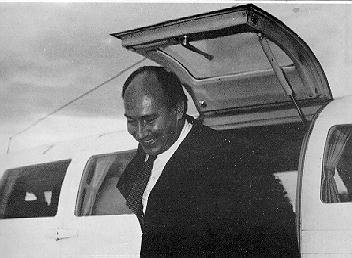
Mowlana Hazar Imam in the Airport Lounge with Sir Eboo, Kisumu, March 1981
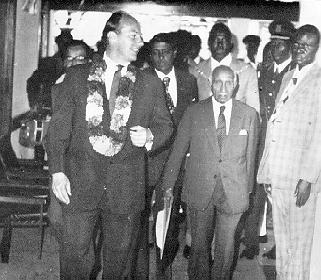
Mowlana Hazar Imam upon arriving at the Kisumu Jamatkhana Complex, 1981
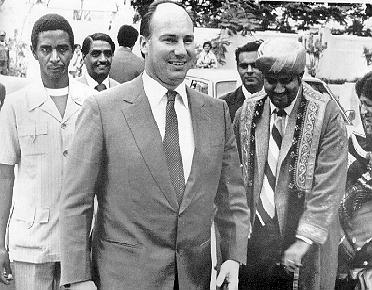
Mowlana Hazar Imam at a banquet in Kisumu, with Commissioner Mr. Cherogony and His Worship the Mayor Ezra Gumbe
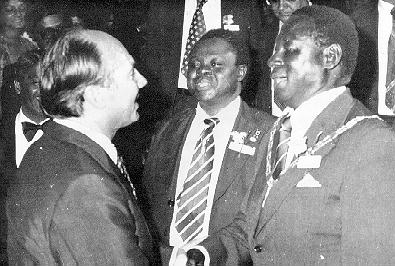
Mowlana Hazar Imam's handwritten message to the people of Kisumu, 1981
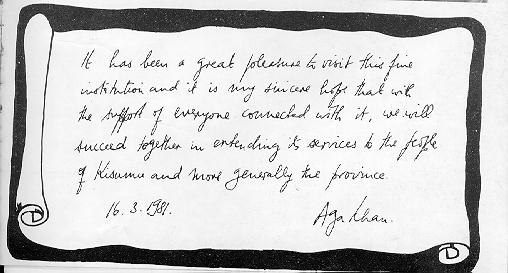
Mowlana Hazar Imam with Girl Guides; Kisumu 1981

Mowlana Hazar Imam with Boy Scouts; Kisumu 1981

Mowlana Hazar Imam with the Food Management Committee (Randhan Committee); Kisumu 1981
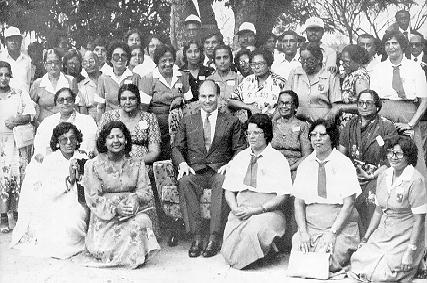
Mowlana Hazar Imam with the Women's Association; Kisumu and Eldorate 1981

Mowlana Hazar Imam with the Transport, Traffic and Security Committee; Kisumu 1981
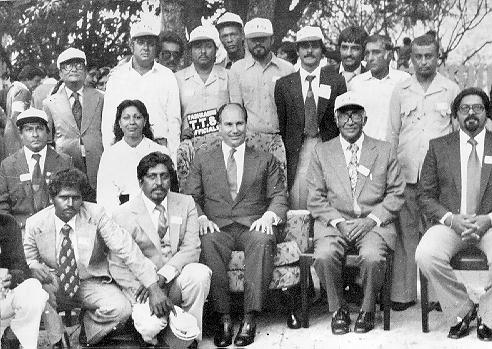
Mowlana Hazar Imam with the Huzur Staff; Kisumu 1981
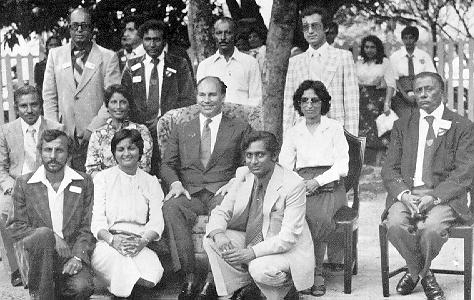
.
Mowlana Hazar Imam arriving in Kisumu, March 1981

Mowlana Hazar Imam in the Airport Lounge with Sir Eboo, Kisumu, March 1981

Mowlana Hazar Imam upon arriving at the Kisumu Jamatkhana Complex, 1981

Mowlana Hazar Imam at a banquet in Kisumu, with Commissioner Mr. Cherogony and His Worship the Mayor Ezra Gumbe

Mowlana Hazar Imam's handwritten message to the people of Kisumu, 1981

Mowlana Hazar Imam with Girl Guides; Kisumu 1981

Mowlana Hazar Imam with Boy Scouts; Kisumu 1981

Mowlana Hazar Imam with the Food Management Committee (Randhan Committee); Kisumu 1981

Mowlana Hazar Imam with the Women's Association; Kisumu and Eldorate 1981

Mowlana Hazar Imam with the Transport, Traffic and Security Committee; Kisumu 1981

Mowlana Hazar Imam with the Huzur Staff; Kisumu 1981

.
A feedback received from
----- Forwarded message from [email protected] -----
Date: Thu, 18 Feb 2021 11:27:49 +0000 (UTC)
From: [email protected]
Subject: Re: Kisumu Visit
Of course Count Hasham Jamal had to be in it. He's in the photo with 48th Imam but it's not showing. He as agent of Allidina Visram brought many Ismailis to Kisumu. When 48th Imam came visiting in 1920 or so he and other Ismaili leadership people started pulling the Imam's carriage. Imam said "Days of Khoja uthau bhoja are over, come sit next to me." (From "101 Ismailis" collection.) The Lakhas came on their own and my grandfather (Valli Jamal; younger brother to Hasham Jamal) records in his diary being with Kassam Lakha in Mumias around 1905. He also mentions being with Kurji Meghji Dossa.
Attached: Photo of Mbale visit February 1972 (the expulsion year).
Late Sultan Ibrahim Mitha was President and sister Zaibun had
privileged conversation with Begum Salimah at the banquet. I was down
with malaria but next day at the didar Hazar Imam did ask me about
being at Stanford (communicated by Begum at his side those days). I
was in Uganda that year collecting data for my dissertation at
Stanford, hence the reference.
Pages from my grandfather's diary extracted into my book.
And some other pages from my book. Out "soon".
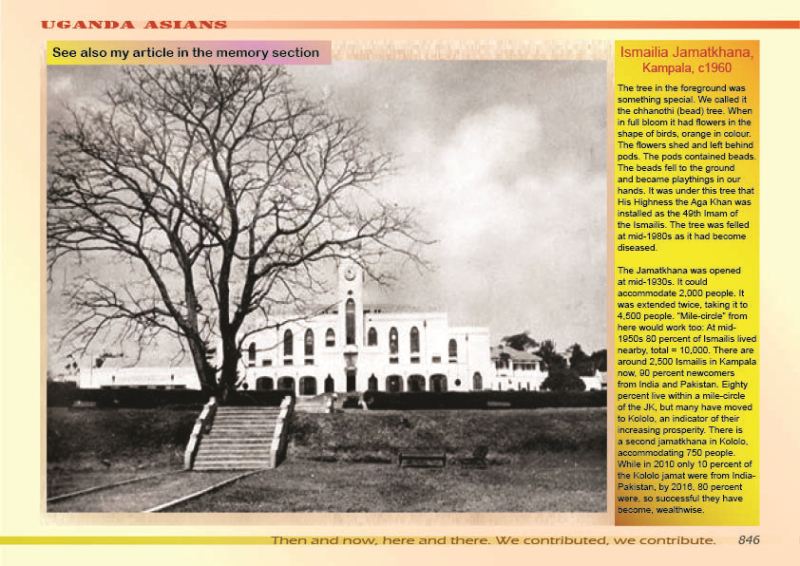
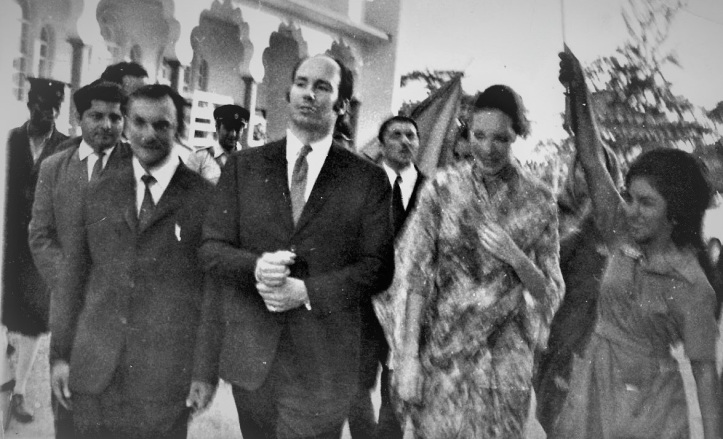
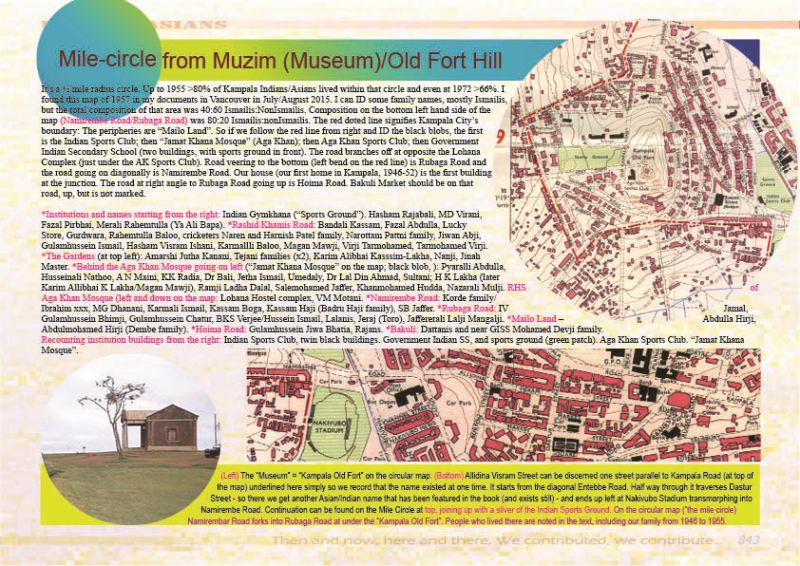
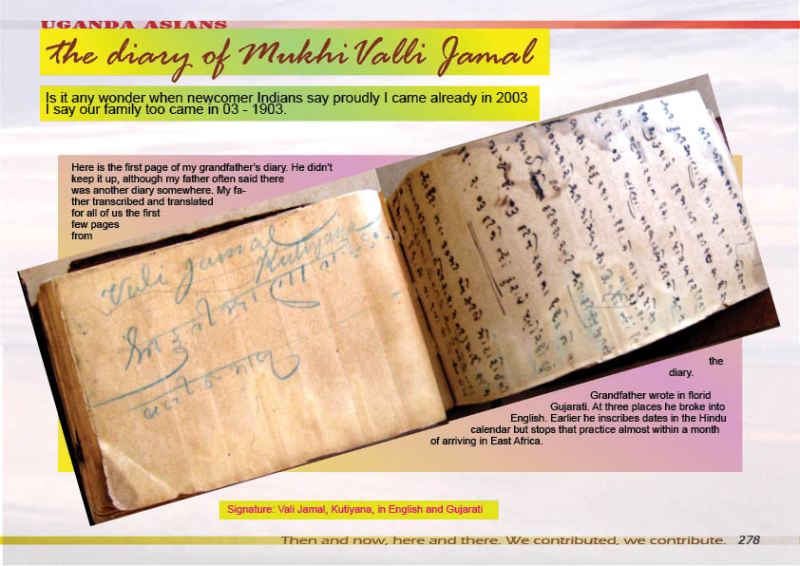
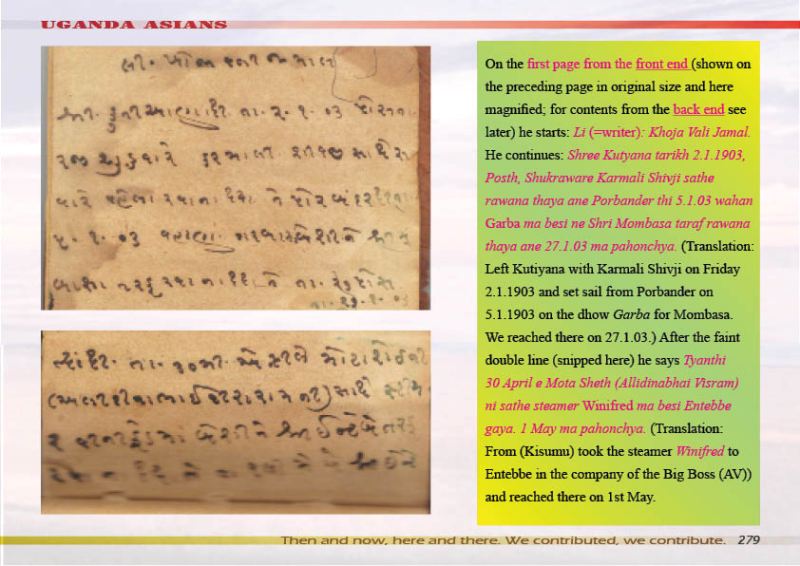
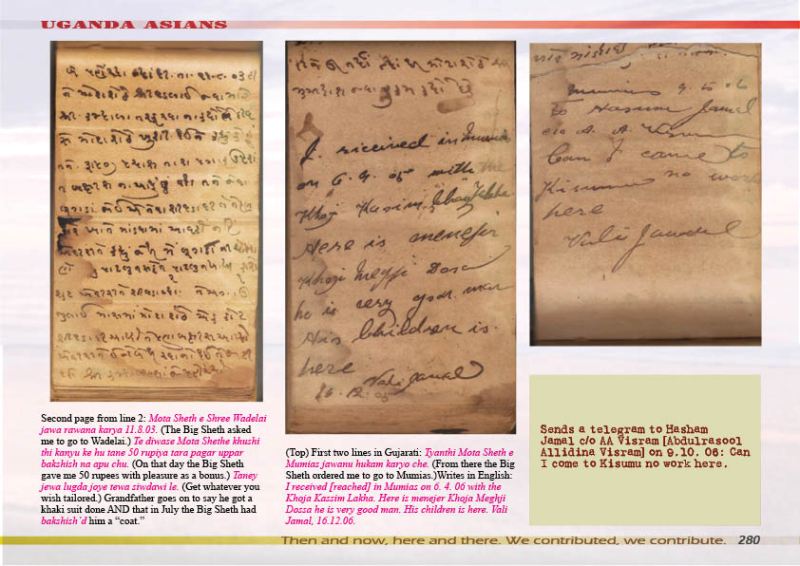
----- Forwarded message from [email protected] -----
Date: Thu, 18 Feb 2021 11:27:49 +0000 (UTC)
From: [email protected]
Subject: Re: Kisumu Visit
Of course Count Hasham Jamal had to be in it. He's in the photo with 48th Imam but it's not showing. He as agent of Allidina Visram brought many Ismailis to Kisumu. When 48th Imam came visiting in 1920 or so he and other Ismaili leadership people started pulling the Imam's carriage. Imam said "Days of Khoja uthau bhoja are over, come sit next to me." (From "101 Ismailis" collection.) The Lakhas came on their own and my grandfather (Valli Jamal; younger brother to Hasham Jamal) records in his diary being with Kassam Lakha in Mumias around 1905. He also mentions being with Kurji Meghji Dossa.
Attached: Photo of Mbale visit February 1972 (the expulsion year).
Late Sultan Ibrahim Mitha was President and sister Zaibun had
privileged conversation with Begum Salimah at the banquet. I was down
with malaria but next day at the didar Hazar Imam did ask me about
being at Stanford (communicated by Begum at his side those days). I
was in Uganda that year collecting data for my dissertation at
Stanford, hence the reference.
Pages from my grandfather's diary extracted into my book.
And some other pages from my book. Out "soon".






Mombasa 1959 Aga Khan, Aga Khan Hostel
Historical photo as received
Aga Khan Hostel was built in 1957. Mowlana Hazar Imam said my Murids are never orphans . The name of the orphanage was changed to hostel
1959 H. Imam in Mombasa - looks like those wearing suits were prefects.
In front of AK Hostel. Mama Ngina Drive - Jimmy Virjee near Mowlana Hazar Imam.
A.V. is standing in the last line (3rd from right), and I think it is Nasser in that same line.
Nizar Vallibhai (called NV) and Amir Vallibhai (called AV).
Prembai in PACHEDI in charge of Kitchen at the Hostel.
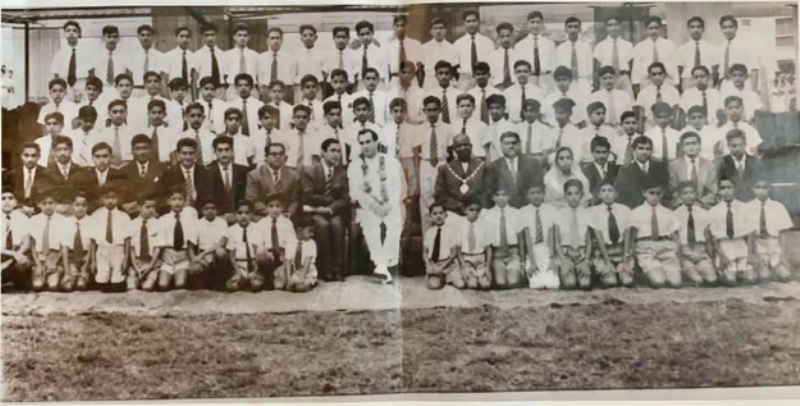
Again here in 1972 with with the Mayor of Mombasa, and the Coast Provincial Commissioner.

.
Aga Khan Hostel was built in 1957. Mowlana Hazar Imam said my Murids are never orphans . The name of the orphanage was changed to hostel
1959 H. Imam in Mombasa - looks like those wearing suits were prefects.
In front of AK Hostel. Mama Ngina Drive - Jimmy Virjee near Mowlana Hazar Imam.
A.V. is standing in the last line (3rd from right), and I think it is Nasser in that same line.
Nizar Vallibhai (called NV) and Amir Vallibhai (called AV).
Prembai in PACHEDI in charge of Kitchen at the Hostel.

Again here in 1972 with with the Mayor of Mombasa, and the Coast Provincial Commissioner.

.
Re: Early Khoja/Ismaili settlements in Africa
THREADS THAT TIE US - The Movie.
This is a movie/documentary, or call it what you will, of immigration of Indians.
Moving within India, from Rajasthan to the semi-desert area of Kutch, to Saurashtra,near the Rann in and around Jamnagar over 450 to 500 Years ....
The film is produced by Bindu Shah, born in Nairobi, Kenya, but now residing in Toronto Canada.
It is about Oshwals, whom you may know of as SHAH s. You may know the Visa Oshwal Mahajanwadi on Limuru Road, and you may know of Oshwal Centre in Parklands. You may know the Visa Oshwal Primary School, you may know of Oshwal Academies, you may know of Oshwal College and you probably have heard of M.P.SHAH HOSPITAL. Those are SHAHs, or OSHWALS .
This is a story that will resonate with every Indian whose ancestors migrated from India towards Kenya, Uganda, Tanzania, towards Zanzibar, Mozambique, towards Madagascar, towards South Africa, the Sudan and even Aden and Somalia.
It is a very similar story for most Indians. From all these countries, many of the 2nd and 3rd generations have moved on to other parts of the world.
They have moved to London(England or UK), to Canada, to Australia,to Europe, to USA in very large numbers and have had their next generations well established there.
This is a movie that those generations need to watch.
Why do they need to watch this ?
Because they need to know their ROOTS.
A plant or tree without firm roots does not survive long.
So if you are a person of Indian origin, no matter which "tribe" - whether you are a Sikh, or Lohana, a Patel, or an Ismaili, a Mochi, or Suthar, or Brahmin, or Luhaar, or Bhadala, or Parsi, or Ishnashri, you need to watch this movie. There is a lot packed into this, and will certainly resonate with everyone, I am sure!
Bindu Shah decided that the first showing of the film would be in her place of birth, Nairobi, on the 4th of February, 2024.
Another showing is planned for the 18th of February in Mombasa.
Do forward this message to your family and friends back in Kenya and do please comment on the movie after you have watched it.
Sent from my Metro by T-Mobile 5G Device
Get Outlook for Android
This is a movie/documentary, or call it what you will, of immigration of Indians.
Moving within India, from Rajasthan to the semi-desert area of Kutch, to Saurashtra,near the Rann in and around Jamnagar over 450 to 500 Years ....
The film is produced by Bindu Shah, born in Nairobi, Kenya, but now residing in Toronto Canada.
It is about Oshwals, whom you may know of as SHAH s. You may know the Visa Oshwal Mahajanwadi on Limuru Road, and you may know of Oshwal Centre in Parklands. You may know the Visa Oshwal Primary School, you may know of Oshwal Academies, you may know of Oshwal College and you probably have heard of M.P.SHAH HOSPITAL. Those are SHAHs, or OSHWALS .
This is a story that will resonate with every Indian whose ancestors migrated from India towards Kenya, Uganda, Tanzania, towards Zanzibar, Mozambique, towards Madagascar, towards South Africa, the Sudan and even Aden and Somalia.
It is a very similar story for most Indians. From all these countries, many of the 2nd and 3rd generations have moved on to other parts of the world.
They have moved to London(England or UK), to Canada, to Australia,to Europe, to USA in very large numbers and have had their next generations well established there.
This is a movie that those generations need to watch.
Why do they need to watch this ?
Because they need to know their ROOTS.
A plant or tree without firm roots does not survive long.
So if you are a person of Indian origin, no matter which "tribe" - whether you are a Sikh, or Lohana, a Patel, or an Ismaili, a Mochi, or Suthar, or Brahmin, or Luhaar, or Bhadala, or Parsi, or Ishnashri, you need to watch this movie. There is a lot packed into this, and will certainly resonate with everyone, I am sure!
Bindu Shah decided that the first showing of the film would be in her place of birth, Nairobi, on the 4th of February, 2024.
Another showing is planned for the 18th of February in Mombasa.
Do forward this message to your family and friends back in Kenya and do please comment on the movie after you have watched it.
Sent from my Metro by T-Mobile 5G Device
Get Outlook for Android
Re: Early Khoja/Ismaili settlements in Africa
As received:
Mbulu, a tiny village of no more than 1500 or so in Arusha region about 50 miles south of Manyara area, was an initial settlement for no more than 6 or 7 Ismaili families, the majority, at least 4 of them were the Hirjis from Kutch province, small time traders and later day wheat and sugar cane farmers
They built a Jamatkhana and a social hall both of the same design at the edge of the entry to the village ...even then they had the early morning 3.45 am bandagi dhikr followed by 5 am prayer ...
The area was prowling with hyenas and even at times lions at that time of the morning...there was no electricity and the folks went to JK carrying a kerosene lamp for light .. yet never was there an incident .. in fact I distinctly remember being told the animals would go quiet as the families passed them at a distance
The Mburus inhabitants of the village and area had their own cunning lingo light years removed from Kiswahili as you would expect .. these families learnt both the local village language and Kiswahili
Mbulu, a tiny village of no more than 1500 or so in Arusha region about 50 miles south of Manyara area, was an initial settlement for no more than 6 or 7 Ismaili families, the majority, at least 4 of them were the Hirjis from Kutch province, small time traders and later day wheat and sugar cane farmers
They built a Jamatkhana and a social hall both of the same design at the edge of the entry to the village ...even then they had the early morning 3.45 am bandagi dhikr followed by 5 am prayer ...
The area was prowling with hyenas and even at times lions at that time of the morning...there was no electricity and the folks went to JK carrying a kerosene lamp for light .. yet never was there an incident .. in fact I distinctly remember being told the animals would go quiet as the families passed them at a distance
The Mburus inhabitants of the village and area had their own cunning lingo light years removed from Kiswahili as you would expect .. these families learnt both the local village language and Kiswahili